 Oceanic Submersibles 1932-1945:
Oceanic Submersibles 1932-1945:
53 total:
Group I 1935-38: Triton, Thunderbolt, Tribune, Trident, Triumph, Taku, Tarpon, Thistle, Tigris, Triad, Truant, Group 3 boats, Talisman, Tetrarch, Torbay
Group II 1939-41: Tempest, Thorn, Thrasher, Traveller, Trooper, Trusty, Turbulent.
Group III 1942-45: P311, Trespasser, Taurus, Tactician, Truculent, Templar, Tally-Ho, Tantalus, Tantivy. Telemachus, Talent, Terrapin, Thorough, Thule, Tudor, Tireless, Token, Tradewind, Trenchant, Tiptoe, Trump, Taciturn, Tapir, Tarn, Talent, Teredo. Tabard, Totem, Truncheon, Turpin, Thermopylae
WW2 British Submersibles:
X1 | Odin | Parthian | Rainbow | Thames | Swordfish | Porpoise/Grampus | Shark | U class | T class | S class | U class 1940 SH | P611 class | V class (U 1941/42 LH) | X-Craft | A classThe Royal Navy’s T class (or Triton class) diesel-electric submarines emerged in 1935 on paper to replace the early interwar O, P, and R classes. This was the start of a very long production unding in 1945, with 53 boats made. They played a major role for the Royal Navy, making the bulk of WW2 oceanic submersibles. The smaller “S” and “U” class, even more numerous were light submersibles mostly deployed in the Mediterranean whereas the T class were designed for distant stations across the Empire, notably in the far east and Asia.
Four later were passed on the Royal Netherlands Navy (Zwaardvisch class). They were a quite advanced type which proved to have a very long service (and heavy losses) maintained until the late 1960s after being streamlined, so to counter the growing Soviet submarine threat. The last one was disposed of in 1969, moored as static training submarine until 1974 while another served with the IDF Navy until scrapped in 1977. Note: Due to the number of boats this post will be only on the first group, Triton. There were also the Group II 1940 programme (Tempest) and Group III 1941-42 Programmes (Trespasser) seen in future posts.
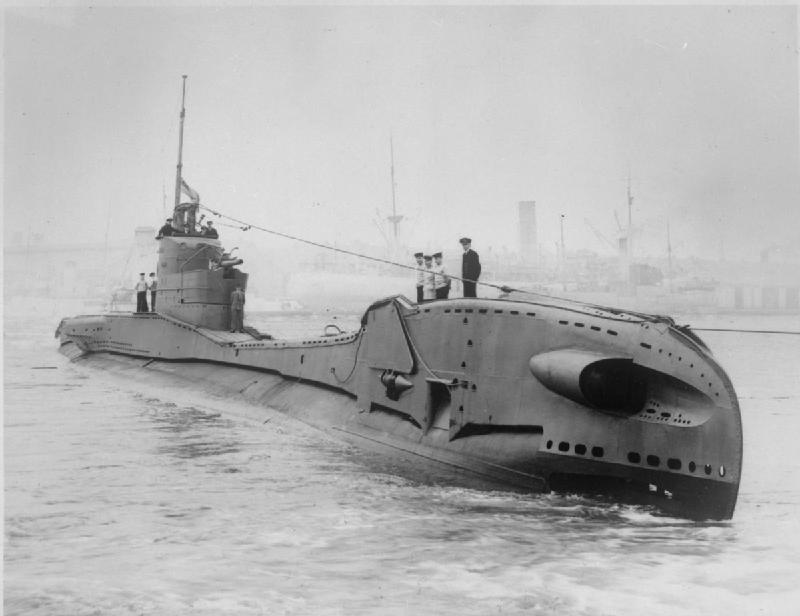
HMS Thorn, Group II, 1940 programme, bow view. The T class were not the most gracious submarines around, but they were tailored for a massive ten torpedo forward volley.
Development
1922-30-35 treaties and conferences
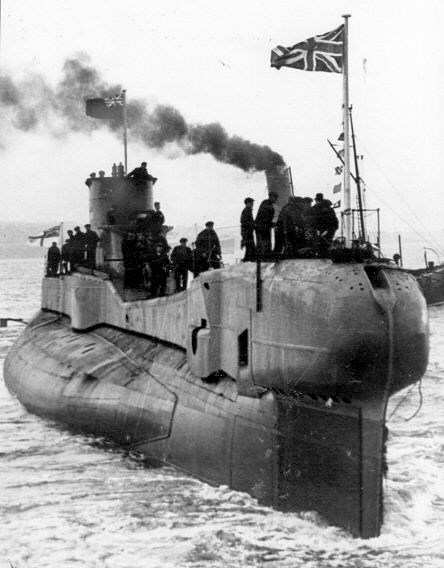 The design of what the future “T class”, the largest operational submarines of Great Britain during the second world war, started in 1934 to create a replacement for the earliest British interwar submarines, namely the O, P, and R classes. Indeed reports piuled up on their use and the admiralty now had a clear idea on how to avoid issues of the past;
The design of what the future “T class”, the largest operational submarines of Great Britain during the second world war, started in 1934 to create a replacement for the earliest British interwar submarines, namely the O, P, and R classes. Indeed reports piuled up on their use and the admiralty now had a clear idea on how to avoid issues of the past;
These large subs proved mechanically unreliable, too large and unwieldy, slow and overcomplicated to operate. The Washington Naval Treaty of 1922 required all these submarines were to be retired after 13 years of service which was the main factor, meaning the Oberon class was scheduled to be paid off in August 1940, meaning with an average time from design start to commission, at least five years. Work for a replacement class thus started in 1934.
There was another hitch: The 1930 London Naval Treaty hardened the 1922 treaty and further restricted British submarine to a total tonnage of 52,700 tons, with an individual surfaced displacement of no more than 2,000 tons regardless of the type, maximum gun armament of 5.1 in (130 mm). The USN in the 1935 London Disarmament Conference argued even for a limit of 1,200 tons, but this was rejected by the British Admiralty as to make their Grampus-class mine-laying submarines illegal.
The Admiralty proposed again a limit at 2,000 tons, hoping that rival naval powers would make fewer but larger submarines based on national pride and easier hunt to down than scores of smaller submarines. The Conservative government of Stanley Baldwin went even further, proposing an outright banning of submarine, or a 250 tons limit. The Admiralty argued that no other power would accept this, as their own submarine fleets were seen as a vital core concept. They would never accept such strict limitations. Instead, the admiralty for a repeat of the P class.
Basic requirements setup (1934)
The O/P/R classes initially were designed with the Pacific in mind, compensating for the low numbers of cruisers and capital ships and better suited for more restricted and shallow waters. They were designed to hunt down the Imperial Japanese Navy capital ships due to the absence of a battlefleet. They acted, as in most navies at the time, as a local deterrence. The planned replacement, called “Repeat P” thus needed at least a similar endurance while being easier to maintain and being smaller to match future treaty restrictions. 1,000 tonnes surfaced (the equivalent of a standard displacement for surface ships) was retained as a baseline for design.
But to draw up future requirements it was advanced that twenty submarines would be ideal, making for a total tonnage of 20,000 tons (On 52,700t global). Rear Admiral of Submarines Noel Laurence, a veteran, awarded WWI sub commander, argued also for a stronger torpedo armament that would give a greater firepower in a single volley rather than more reloadable torpedoes. He argued that penetrating the Japanese destroyer screen would be difficult and thus, a larger salvo with longer range torpedoes was ideal. They would be setup using only ASDIC data to find a firing solution.
On 27 February 1934, the Director of Naval Construction (DNC) was Sir Arthur Johns. Her asked to study designs for a 1,000 ton displacement “patrol submarine” and initially two DNC designs were drafted, called DNC ‘A’ and DNC ‘B’ used as base for discussions in November 1934 and create a staff requirement. The base was an armament of six internal 21 inch torpedo tubes (reloadable), two external tubes (not reloadable), one 3-inch or 4-inch on deck depending on stability calculation, and a range of no less than 4,000 nmi at 11 knots, or a 28-day patrol more or less related to 5,500 nmi at 11 knots.
Submerged endurance was set up at 15 hours at 2 knots or eight hours at 5 knots for the final approach, maximum submerged speed of 9 knots, surfaced speed of 15 knots and diving depth of 300 feet. Rear Admiral Laurence also suggested a variant fitted with a double hull for greater survivability under attack, but this was rejected by the DNC citing the lack of experience in this matter and favouring of a more conventional saddle tanks/pressure hull combination.
1935 Final Design and acceptance

T class, likely Group I src
In early 1935, the still named “Repeat P” design was to have a smaller displacement than 1,000 tons to comply with the 1935 London conference limitations. Design ‘C’ as drafted sacrificed machinery space and managed to get the surfaced speed reduce to 14.5 knots, surfaced endurance to 8,600 nmi at 8 knots. Design ‘D’ went further and eliminating external fuel stowage which was a leak sourced anyway on previous O, P, and R classes for pressure hull internal stowage, but all argued that it was impossible to meet below 1,000 tons without unacceptable reductions and thus, it was raised up to 1,075 tons as a compromise.
There was a slight reduction in length and fresh water diving requirement also to have a lighter hull, and due to the emergency, the final design was agreed upon in May 1935. On 24 June 1935, “Repeat P” was swapped to the next letter “T” and by 3 September 1935, the name “Triton” was selected for the lead boat, with final approval coming on 13 February 1936. In between, the “repeat P” already had been provisionally included and authorized in the 1935 naval program, secured by law at the House of Commons. The admiralty then invited for tenders Vickers, Cammell Laird, and Scotts on 5 December 1935. On 5 March 1936, two years after the process started, the contract was awarded for the Triton batch to Vickers Armstrong under the 1935 Programme. She was the only one ordered that year in the hope to find construction issues and correct the next ones. Later, Chatham NyD was contracted for the third and fourth batch.
Construction planning: 1935, 36, 37, 38 programmes
These 15 pre-war submarines of the “T class” were ordered under the Programmes of 1935 (Triton alone), 1936 (next four: Thetis at Cammell Laird (later Thunderbolt) Tribune at Scotts, Trident at Cammell Laird, Triumph at Vickers), 1937 prgramme (next seven: Taku at Cammell Laird, Tarpon at Scots, Thistle at Vickers, Tigris at Chatham, Triad at Vickers, Truant at Vickers, Tuna at Scotts) and programme 1938 (last three: Talisman at Cammell Laird, Tetrarch at Vickers, Torbay at Chatham). The names for the T class were a repeat of the destroyers names of WW1 and not related to anything marine in particular, apart to some exceptions. “Tigris” was a Mesopotamian river, Taku and Triad were Chinese-related (where they were supposed to serve, notably from Hong-Kong) and only Triton (fitting as the son of the sea god Poseidon and the sea nymph Amphitrite, with a fishtail and human body), Trident, and Tuna were sea-related. Torbay is a famous bay in Devon.
Construction time on average was two years. This was of course improved in the war years. HMS Triton took 2 years and 4 months, HMS Torbay one years and two months. She was the very last launched, in January 1941. Only three of the class were completed when WW2 broke up, and the consequence was to free tonnage from all treaties. Soon a Group II (War emergency 1940 program) planned sixteen “repeats” launched in 1941-43, completed in 1943 (see later).
Design of the class
The design of the T-class submarines was dictated by at first their very large forward torpedo salvo and long patrol endurance for the Pacific while still comply with stringent treaty restrictions. These were extremely challenging requirements and so compromises led soon to modify operational experience before and during the war, leading to three diverging groups. The next A class was a return to a treaty-free ideal Pacific long range submarine.
Hull and general design
The six bow tubes were not different, but the bow was bulbous and peculiar, notably to accommodate the external forward torpedo tubes, with the original bow shape later was found affecting speed while surfaced. Two of the Group One boats, Triumph and Thunderbolt, in fact had their external bow tubes deleted during refit and this resulted in a finer bow shape.
The Triton class were still of well mastered riveted construction as the riveted hull proved remarkably strong and indeed, on tests these boats exceeding their rated diving depth of 300 ft (91 m) in combat missions, Tetrarch even survived a 400 ft (122 m) dive on 23 April 1940. Welding was applied from Group III boats and allowed greater depths.
HMS Triton had a very high open bridge and was found to plough a lot, with a lot of draught. It was reworked for the remainder of the class, with a new shape, but even with the new breastwork, the lower bridge and gun crew were exposed to sea spray and splashes in heavy weather.
Some Group One boats had also cab-type bridge, subsequently standardised for Group Two boats. But it was reverted later to open bridges, as greater visibility was more important than the better habitability. Group III returned indeed to these.
Also, brass for the CT was used instead of steel to prevent interfering with the magnetic compass, but this causes structural weaknesses. It proved impossible to fit heavy machine guns due to the vibrations, either Vickers quad 0.5 which would have been ideal at the rear platform, or a twin 0.5 Browning HMG. But the recoil was just too much. Instead, 0.303 Vickers, Brens, Lewis were preferred, but they were a poor answer to 600 kph capable fight bombers in 1942. At last in 1944 some received 20 mm Oerlikon cannons, which recoil was well buffeted enough to cause minimal vibrations (see later).
The triton class had eleven main ballast tanks and two auxiliary tanks for adjusting the trim, as well as five compensating tanks for adjusting to changes in water density (tropical, northern/Arctic). Some were usable as stores in the first leg of the tip, especially packed food. The bow Q tank was used for diving quicker and rapid changes in depth. Two main tanks were converted into fuel tanks later in Group 3. Diving time at 50% buoyancy was judged good by British standards, with 30 seconds dive time.
Powerplant
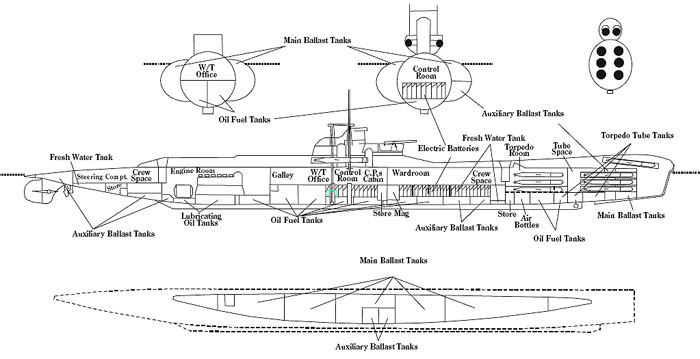
Cutout of the Group II src
The Triton class used various diesel engines, mostly yard dependent. Vickers-built boats had of course Vickers engines, Royal Dockyards boats used Admiralty diesel engines, Cammell Laird boats used Sulzer engines and the Scotts boats (prewar) even used recently purchased German MAN supercharged diesel engines. In all cases, this power was passed on to two shafts with triple bladed props, and each diesel was rated for 1,250 brake horsepower (930 kW). Top surface speed was 15 knots (28 km/h; 17 mph) in normal use. Triton even achieved on trials, light and in good water conditions, 16.29 knots (30.17 km/h; 18.75 mph) and this was never repeated by any of the other T-class. The average on trials was 14–15 knots (26–28 km/h; 16–17 mph) and in mission depending on the weather on the Triton class, it could fell rapidly below 10 knots, improved in heavy weather for the next groups.
The Vickers diesels were 6-cylinder 4-stroke 1,250 bhp injection engines that became widespread in the T class. They proved to be very reliable, albeit less advanced than MAN diesels, which were however a bit finicky. These could continue running even if one cylinder failed. The engineers just had to disconnect the faulty cylinder from the crankshaft. It was well appreciated by captains when breakdowns occurred, as to not being found dead in the water.
The 12 boats from Royal Dockyards and their Admiralty diesel engines had the same reliability even though they were more complicated and less easy to maintain, but they offered the same advantages of flexibility.
MAN diesels were high-end products, ordered in 1938 when relations with Germany were still good, but they proved troublesome. They ended built under licence and still needed parts and expertise in Germany, so that was out of the window when the war broke up. By 1943, just two T-class, Tuna and Tribune ran with them, and were relegated to training use due to their complicated maintenance and poor reliability. In fact, they were banned from the far east in March 1944. The Cammell Laird used Swiss licence-built Sulzer 2-stroke engines. They were not always well appreciated, working well on Thrasher and Thorn (Group II) but having issues on others. At full speed they were fragile, with cracked cylinders rings and blocks.
Submerged speed counted on the Triton class or a massive 336-cell battery ensemble. They passed on their power to two 1,450 bhp (1,080 kW) Laurence Scott electric motors, chosen for all T class. They managed to give an endurance of 48 hours, at just 2.5 knots (4.6 km/h; 2.9 mph) and one hour at 9 knots (17 km/h; 10 mph). The battery however proved vulnerable to shock damage from concussion caused by depth charges.
Armament

A group II being side-launched. Note the upper outer tubes and lower internal (pressure hull) tubes differences are clearly visible.
British work on ASDIC led the admiralty to believe other nations developed similar systems in secret, and that played on was the armament was composed. Facing detection and a robust ASW counter-attack, the tactic defined was a long range approach below periscope depth and using ASDIC. Inaccuracies being the result, the planners included a large salvo of eight torpedoes. It was also assumed that international treaties would prevent unrestricted and so anti-shipping warfare, so that the T class were reserved to hunt down warships only. Against valuable assets of the enemy, all captains knew they had only a single window chance to attack. A large salvo was desirable, and from four-six usually fitted, no less than ten-torpedo tubes were decided for the pre-war T-class. It remained the largest ever fitted to any operational submarine, as all were launched forward. Reloading was a secondary matter.
However, hull constraints meant only six could be fitted internally of course of the 21-inch (533 mm) standard, in the bow, fitted with bow shutters on the Tritons to reduce underwater drag, but they were prone to jamming from flotsam and abandoned for Group II-III.
The loss of Thetis on trials was due to the unintentional opening of the rear door of a torpedo tube while its bow cap was open. Thus to avoid this in the future, all submarines in construction were given a special safety feature, the “Thetis clip”. It only opened the rear torpedo tube door by a fraction if the bow cap was not in place, showing an immediate leak and measures to be taken. There were six reload torpedoes in the torpedo stowage compartment at the bow only. The remaining tubes were loaded at port only. The reloading process was of course fully manual and could take 5 minutes per tube ever for a trained crew. However, a semi-automated loading system was tested on HMS Triumph in 1939, after another earlier test on the old HMS Grampus. It was not adopted as underpowered. No effort in wartime was done to get one.
The four external “E-type” 21-inch torpedo tubes were all forward-facing, in the outer hull, in order to avoid compromising the structural integrity of the pressure hull. It prevented maintenance, reloading, but also withdraw the torpedo once in the tube in case of misfire, still a hazard due to the percussion cap. These tubes angled were downwards at a 5° bow angle, but 0° on Triton. Two tubes were in the bow, two amidships at the base of the conning tower, and the bow caps were opened manually with great time and effort. Being outer tubes, they were also prone to damage. Two had them removed during reconstruction.
Debate over the introduction of stern torpedo tubes raged pre-war, and their effectiveness was mostly considered to be doubtful while take up valuable space in the pressure hull. Wartime experience changed that perception. Commander Anthony Miers of HMS Torbay complained about it as he missed several occasions. There was no point turning the boat to face a target that would be, once spotted, far away. Eight Group 1, Taku, Thunderbolt, Tigris, Torbay, Tribune, Trident, Truant, and Tuna were later thus retrofitted with an eleventh external torpedo tube rearwards in the outer hull. This soon became standard as an easy modification.
10x 533 mm Torpedo Tubes
The primary torpedo used by the Triton class was the 21-inch Mark VIII torpedo, as planned. But quickly it was superseded by the Mark VIII**. The Mark VIII was the first burner-cycle torpedo in service, studied in 1925 and completed for production and service in 1927. The improved Mark VIII**was used far more than any other British torpedo during the war with 3,732 fired by September 1944 which represented 56.4% of the total of all models. Incredibly, it was still in serviced as late as 1983 for the Falklands war (of Belgrano sinking fame). Their tally in the Mediterranean and beyond was on par with the German G7e in the Atlantic, and US Mark 14 (after corrections) in the Pacific.
This 1,566 kg (3,452 lb) model, 21 ft 7 in (6.579 m) long, carried a 365 kg (805 lb) Torpex warhead and used a Brotherhood burner-cycle engine for a range of 4,570 meters (5,000 yards) at 45.5 knots (84.3 km/h; 52.4 mph) or 6,400 meters (7,000 yards) at 41 knots (76 km/h; 47 mph). It had a greater propulsive efficiency than any contemporary torpedo of similar size. Shortages of the Mark VIII early in the war pushed many T class to be equipped with much older Mark IV models. The latter was a wet-heater 1916 model Weighting 3,206 lbs. (1,454 kg) for 22 ft 7.5 in (6.896 m) in length,
with 515 lbs. (234 kg) TNT warhead, capable of 8,000 yards (7,300 m) at 35 knots, 10,000 yards (9,150 m) at 29 knots or 13,500 yards (12,350 m) at 25 knots. It was slow, but its range was revised in WW2 with a new setup for all Mark IV* to 6,000 yards (5,500 m) at 40 knots and 9,500 yards (8,700 m) at 35 knots.
The Mark VIII was primarily fitted with a contact pistol detonating upon impact until a non-contact magnetic pistol, the CCR (Compensated Coil Rod) was developed and fitted. However, like for the Mark 14 and German models, it gave endless troubles, being withdrawn. Development problems with postwar torpedoes had the VIII lingering in service with the T class, A class, and all diesel-electric subs, even the first British SSNs until 1971 and slow introduction of the Mark 23 wire-guided torpedo.
⚙ specs. Mark VIII** TORPEDO |
|
| Weight | 1,566 kg (3,452 lb) |
| Dimensions | 21 ft 7 in (6.579 m) |
| Propulsion | Brotherhood burner-cycle engine |
| Range/speed setting | 4,570 m/45.5 kn, 6,400 m/41 kn |
| Warhead | 365 kg (805 lb) Torpex |
| Guidance | Straight, initial training setup |
QF 4 inch (100 mm) deck gun

All T-class submarines were fitted after stability calculations with a single 4-inch (102 mm) deck gun to supplement torpedoes and for self-defence. Either this was the 4-inch QF Mark XII or XXII which were both interchangeable, using the universal S1 mounting located above the casing, forward of the conning tower. Like older subs and typical of British models, to avoid it being awash with seawater spray, it was placed on an elevated position in front of the conning tower, behind a characteristic breastwork rotating with the gun. This provides room for the crew but less easy traverse.
No armour or overhead protection was provided for it, however, due to weight restrictions. However in wartime, Group II HMS Tabard, Talent, and Teredo and others received improvised gun shields from far east depot ships. The gun crew was five. There was a small hatch to access more rounds below in the CT. T-class submarines were allocated 100 rounds of ammunition, that needed to be brought back from below in a chain. This proved insufficient as per combat reports of Group I boat (Triton) and was increased. In fact, in 1945 no reload torpedoes were carried, but more rounds instead.
The Mark XXII equipped the WW1/Interwar L class, Odin, Parthian, River, Grampus, Triton, S and Some of the Amphion (“A” or Acheron) class.
⚙ specifications QF 4-in (101.6 mm) Mark XXII |
|
| Weight | 2,750 pounds (1,250 kg) barrel & breech |
| Barrel lenght | 160 inches (4.064 m) bore (40 calibres) |
| Elevation/Traverse | -10° to +20°, 150° either side arc |
| Loading system | Horizontal sliding-block breech |
| Muzzle velocity | 1,873 feet per second (571 m/s) |
| Range | 11,580 yards (10,590 m) at +30° |
| Guidance | Optcal |
| Crew | 4-5 |
| Round | Fixed QF 31 Pd (14.06 kg), 35 pounds (15.88 kg) from 1944 |
| Rate of Fire | 5 rpm |
AA Defence
The standard anti-aircraft armament was limited to three .303-inch light machine guns and even initially Lewis guns as completed. From 1941 onward, Group II-III, these were replaced with Vickers gas-operated (VGO) machine gun, sometimes substituted with a Bren gun if supplies could be delivered from the Army. In 1945, all T class that underwent a refit, received a 20 mm Oerlikon AA gun located aft of the conning tower. The later HMS Tantivy even had two 20 mm cannons side by side, and Tireless was completed with a twin Oerlikon Mark 12A. Terrapin acquired a .50 inch Browning air-cooled machine gun, but it was too powerful for the conning tower structure in Brass, easily damaged.
Sensors
Type 129 sonar
A keel-fitted model, 10 kHz as standard frequency. It was first trialled behind a dome at the forward end of the keel of HMS Seawolf in 1937 (S class) and in 1938 adopted as standard, installed on the T Class, U Class, and V Class. It was fitted in a cylindrical cage with streamlined dome underneath the forward torpedo tubes. There was a watertight electric motor inside the pressure hull to drive the oscillator. But the dome would also be reached internally for maintenance, repair or exchange. HMS Torbay had the first trying this, by isolating the fore ends and having enough pressure in the compartment to counteract sea pressure before opening the hatch and withdrawing the oscillator, re-shutting the hatch, with the process later reversed. This procedure was later adopted on all T class submarines and other classes as well.
Type 138 sonar
Because of its location, the Type 129 had a blind stern arc. From 1943 (so for Group II-III) a passive and manually-trained listening hydrophone was added to cover the rear blind arc, to complement the more versatile Type 129. On the T Class it was located in the after casing between 9 and 10 tube, accommodated in the engine room, and this caused considerable problems.

HMS Triton
⚙ Triton class specifications |
|
| Displacement | 1,090 tons surfaced, 1,326-1,575 tons submerged* |
| Dimensions | 276 ft 6 in x 25 ft 6 in x 12 ft 9 in/14 ft 7 in (84.28 x 7.77 x 3.89 fwd/4.45 aft m*) |
| Propulsion | 2 shafts diesel engines***, 1,250 hp (930 kW), 2 electric motors 1,450 hp (1,080 kW) |
| Speed | 15.5 knots (28.7 km/h; 17.8 mph) surfaced, 9 knots (17 km/h; 10 mph) submerged |
| Range | 131 tons**** fuel, Range 8,000 nmi (15,000 km; 9,200 mi)/10 kn surfaced |
| Armament | 6 bow TTs, 4 external (16 torpedoes), QF 4 inch (100 mm) deck gun |
| Mex depth | 250 ft (80m) normal, 300ft (96 m) max, 400+ ft crush. |
| Sensors | type 129, 138 sonars |
| Crew | 48-59 |
*Triton 1,331/1,585t
**4347.4.58m for conways
***Default Vickers. Tigris, Torbay Admiralty diesels, Tribune, Tarpon, Tuna MAN diesels, Thunderbolt, Trident, Taku, Talisman Sulzer diesels.
****178t Trident, Torbay post refit.
General Overview

These fifteen pre-war submarines were ordered under the Programmes of 1935, 1936 (4), 1937 (7) and 1938 (3) and all had a bulbous bow covering the two forward external torpedo tubes which reduced surface speed in rough weather. They were removed from Triumph/Thetis during extensive repairs. Only six survived the war, less than half of the class. About the bow, Group Two boats had their external bow tubes moved further back, making for a finer bow shape and causing speed loss. Two of the external torpedo tubes were also reversed, facing aft, and there was an additional rear torpedo tube, creating a characteristic hump. The final Group Three had their bows refined further with a new casing around the conning tower and the rear-facing torpedo tubes flattened for a much smoother profile. From there, the much larger A type were designed.
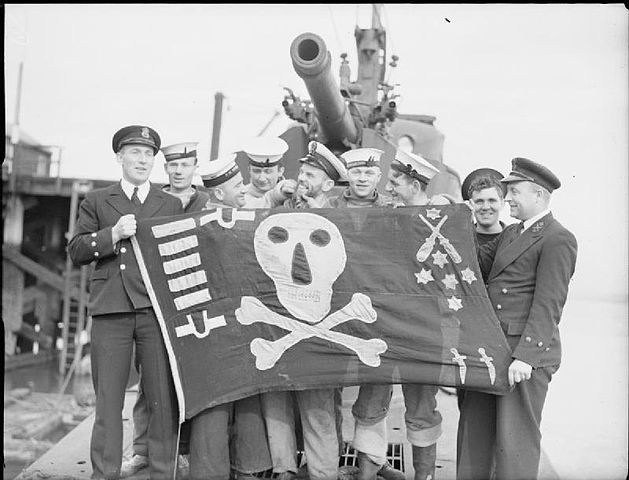
Jolly Rogers displayed by HMS Thunderbolt’s crew
Combat patrols were eventually done in the shallower Mediterranean, not the far east as planned. Triton was sunk in the Adriatic Sea on 18 December 1940, Thetis sank during trials in 1939 (all hands) and was salvaged, repaired, modified, recommissioned as Thunderbolt, in October 1940. She was sunk by the Italian corvette Cicogna off Messina, 14 March 1942. Triumph was lost (probably Italian mines) on 14 January 1942, Tarpon (probably German minesweeper M-6) on 14 April 1940, Thistle was torpedoed by U-4 on 10 April 1940 off Norway, Tigris (probably sunk by German ship UJ-2210) on 27 February 1943, Triad by gunfire from Italian submarine Enrico Toti in the Gulf of Taranto, 15 October 1940, Talisman lost 17 September 1942 Mediterranean (probably Italian mines) and Tetrarch lost in Mediterranean (27 October 1941) due to Italian mines.
Tribune was one of six boats which survived the war. Built at Scotts in Greenock she was scrapped 1947, Trident in 1946, Taku in 1946, Truant was wrecked 1946 on way to breakers, Tuna was scrapped 1946 and Torbay in 1947.
Overall, they were liked for some points, like their greater torpedo firepower compared to any previous models, great range, but they were heavily criticized for their poor seaworthiness in heavy weather, which made them barred from the Atlantic and relocated instead in the Mediterranean.
Improvements: Group 2 and 3 boats
Group 2 boats
Group 2 boats

General outline of Group II boats
They were all ordered under the 1939 War Emergency Programme, Thrasher being launched on 5 November 1940. They underwent scores of modifications (see below).
The class comprised Tempest, Thorn, Traveller, Trooper, Turbulent (most successful, sinking 90,000 tons of enemy shipping). They, too, had a lot of losses. The torpedo tubes were revised. The external ones were moved 7 feet aft to help with sea keeping. The two external forward-angled tubes close to the conning tower were repositioned aft, angled backwards to fire astern, plus another stern external torpedo tube in chase.
The forward volley was thus reduced to eight, three aft. Still 16 torpedoes in reserve, albeit changed for more gun ammo. They all had a cap to reduce drag on Group I, but this caused problems, and later the tubes had reshaped orifices, for minimal drag. Construction was revised also and introduced welding, whereas their CT shape was now standard with enclosed cabs (which was not appreciated). All Group 2 soldiered like the Group 1 in the Mediterranean.
The adoption of an outer tube facing rearwards at the stern was tried on several Triton boats, and this became standard on the Group 2 whereas amidships torpedo tubes were moved aft of the conning tower, also facing rearwards to alleviate captain complaints and giving them more options. Initially angled at 10° off the centreline, this was later modified due to issue with made maintaining depth: HMS Traveller and Trooper and Group 3 boats had their angle reduced to 7°.
Group 3 boats

HMS Trenchant in 1944, author’s profile
This was by far the largest wartime group, with more than 31 boats. Welding was made mandatory for the whole construction after a lot of hesitation from July 1942, for the pressure hull only, then the entire hull in 1944. Being stronger and able to stay under 350 ft (107 m), they also carried more fuel in external ballast tanks, and the early riveted external ballast tanks became welded as they were sent to the Far East. Indeed, oil leaks often betrayed their presence. The final estimated crush depth was estimated to 626 ft (191 m), which enabled to escape most ASW attacks. The same conclusion was reached for the late U-Boats, including the Type XXI.
Wartime austerity also urged production simplified, so they made without their jack staffs and guardrails and a single anchor. Internal pipework was now in steel, not in copper. Fuel capacity ended at 230 long tons (230 t) for a 11,000 nmi (20,000 km; 13,000 mi) surface range at 10 knots (19 km/h; 12 mph). But after the loss of HMS Tempest in 1942 (lead boat Group II) changed were made to the protection of the batteries. Indeed, she had to surface in emergency after being depth-charged, being poisoned by chlorine gas from poorly protected battery cells combined with seawater leaks. She had to surrender. Instead of changing the batteries, it was decided for Group III boats to strengthen the battery compartment with rubber shock absorbers. HMS Terrapin survived a prolonged depth charge attack and kept her batteries working.
Nine were ordered under the 1940 Programme, P311 (lost before formally named Tutankhamen), trusty, Tactician, Tally Ho, Tantalus, Tantivy, Taurus, Templar, Trespasser, and truculent.
17 more were ordered under the 1941 Programme: Telemachus, Talent (Zwaardvisch), Terrapin, Thorough, Thule, Tudor, Tireless, Token, Tradewind, Trenchant, Tiptoe, Trump, Taciturn, Tapir (Zeehond), Tarn (Tijgerhaai), Talent, Teredo.
14 submarines were ordered under the 1942 Programme, five completed: Tabard, Totem (INS Dakar), Truncheon (INS Dolphin), Turpin (INS Leviathan), Thermopylae and nine ordered but cancelled on 29 October 1945, Thor (laid down at Portsmouth 5 April 1943, launched on 18 April 1944), Tiara (launched 18 April 1944), Theban, Talent, Threat and four unnamed, P345, P346, P347 and P348.
⚙ specifications Group II |
|
| Displacement | 1,290 tons surfaced, 1,560 tons submerged |
| Dimensions | 276 ft 6 in x 25 ft 6 in x 12 ft 9 in* (84.28 x 7.77 x 3.89 m) |
| Propulsion | 2x diesels 1,250 hp (930 kW), 2x electric motors 1,450 hp (1,080 kW) |
| Speed | 15.5 knots (28.7 km/h; 17.8 mph) surfaced, 9 knots (17 km/h; 10 mph) submerged |
| Range | 131 tons fuel oil, 8,000 nmi (15,000 km; 9,200 mi) at 10 knots surfaced |
| Armament | 6 bow TTs, 4 external (16 torpedoes), QF 4 inch (100 mm) deck gun |
| Sensors | |
| Crew | 48 |
*14 ft 7 in (4.45 m) aft
Group III, 1940,41,42 war emergency programmes

HMS Totem in September 1945 SLV Greene, CC
Wartime imposed the construction of new submarines, but austerity imposed a reduction of refinements and simplifications, such as jackstaffs, guardrails, single anchor. The internal pipework was steel rather than copper. But that was about it. They also had the later conning tower design. Welding also gradually replaced riveting. 1942 program boats were completely welded, and they had an improved rated maximum diving depth of 350 ft (107 m).
The first Group 3 was HMS P311 launched on 10 June 1942. She remained under that name, instead of her pre-assigned Tutankhamen as formally assigned, but this was a bit of conundrum. Another wartime simplification was to have them unnamed a bit like ancient torpedo boats or destroyers in 1919-1920 in Japan. There were just enough named to come by, especially no inspiring name in the “T” range. However just like in Japan, a crucial fact was missed by the bean counters in charge: The Esprit de Corps of a crew required a sens of belonging to a ship, and declaring it to be “B525” of whaveter identifier attributed was just not going to cut it. This decision did not came out of the blue.
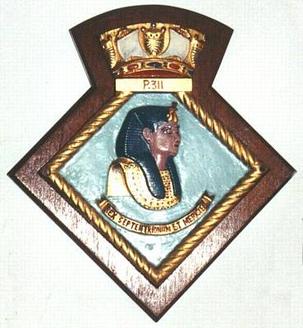 In WWI indeed submarines were named by class “A, B, C ect. with a number for each boat. This enabled the Navy to know the capability of each boat deployed (characteristics by class name) but some captains complained already of this “second rate” consideration, absence of attachment to their boat compared to destroyer’s crews for example. After all, in the RN the submarine service was considered with contempt for most old brass. This made crews in return a bit rebellious, notably with the practice in typical British Humor sense, displaying a skull and bones flag at their return of a successful patrol.
In WWI indeed submarines were named by class “A, B, C ect. with a number for each boat. This enabled the Navy to know the capability of each boat deployed (characteristics by class name) but some captains complained already of this “second rate” consideration, absence of attachment to their boat compared to destroyer’s crews for example. After all, in the RN the submarine service was considered with contempt for most old brass. This made crews in return a bit rebellious, notably with the practice in typical British Humor sense, displaying a skull and bones flag at their return of a successful patrol.
Many in the RN saw these crews as a bunch of misfits, the rejected of other service, with a lax discipline and far too approachable 1st lieutnenants. By ranks captains had the same inferior rank as the former Torpedo Boats. All, this, despite the lackuster names of the WWI British submarine arm, still managed to create a strong sense of crew cohesion and pride in the service, “against” the rest of the RN, which suvived to this day. In WW2 under Winston Churchill, which was fond of submarines, opposed any return to these practices and all submarines bore names.
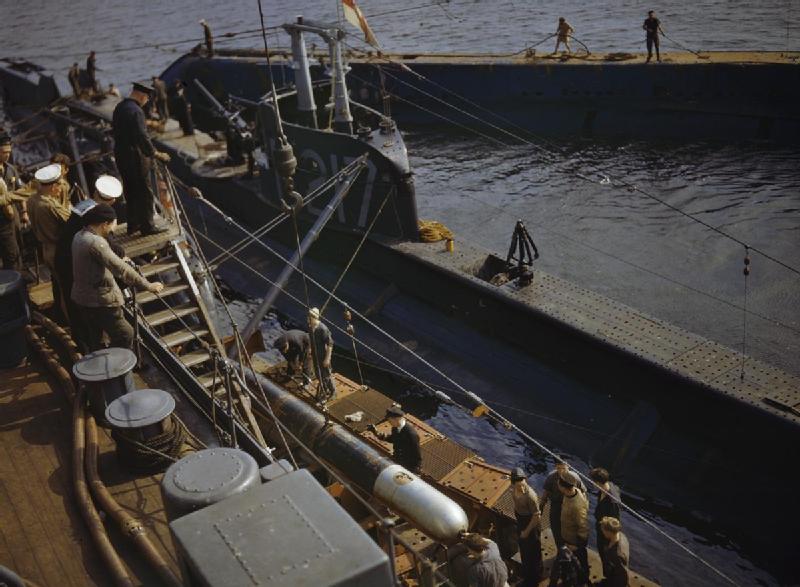
P11 being resupplied alongside HMS Forth on, Holy Loch, Scotland.
All boats (not only of the T class) had aprovisional “P” identifiers. When P311 was laid down on 25 April 1941 there was no hurry to give it a name. So much so, she was still unnamed when launched on 7 August 1942 and eve still unnamed on 7 August. However the prime minister, Winston Churchill, minuted the Admiralty on 5 November, 19 December, and 27 December, about this particular boat, recalling that all submarines should have names. There was a list of suggestions, and he insisted that all unnamed submarines should be named as soon as possible. “Tutankhamen” after the Egyptian king (sole of that name ever) was to be attributed in a formal ceremony. But P311 was lost in the Mediterranean between late December 1942 or early January 1943, before it could be formally assigned.
-9 submarines were ordered under the 1940 Programme:
P311, Trespasser, Taurus (to Royal Netherlands Navy (RNN) as Dolfijn), Tactician, Truculent (sunk in collision 12 January 1950), Templar, Tally-Ho, Tantalus, Tantivy
-17 submarines were ordered under the 1941 Programme:
Telemachus, Talent (P322) (to the RNN as Zwaardvisch), Terrapin, Thorough, Thule, Tudor, Tireless, Token, Tradewind, Trenchant, Tiptoe, Trump, Taciturn, Tapir (to the RNN as Zeehond), Tarn (to the RNN as Tijgerhaai), Talent (P337) and “Teredo”.
-14 submarines were ordered under the 1942 Programme, only 5 completed:
Tabard, Totem (lost in accident on passage to Israel as INS Dakar), Truncheon (later Israeli INS Dolphin), Turpin (later Israeli INS Leviathan) and Thermopylae.
The other 9 were ordered but cancelled on 29 October 1945. They were the following:
HMS Thor (P349) was laid down at Portsmouth Dockyard on 5 April 1943, launched on 18 April 1944, not completed on V-day, sold for scrap to Rees Shipbreaking Co. Ltd. of Llanelli in Wales in July 1946. Sole RN vessel ever to be named after the mythological Norse god of thunder.
HMS Tiara was laid down the same and also launched on 18 April 1944 at Portsmouth, but never completed also scrapped postwar.
There were also HMS Theban (P341), Talent (P343) and Threat (P344) were all launched but in an even lower completion state when cancelled in 1945. And there were four unnamed submarines (P345, P346, P347 and P348) that were never laid down, well advanced in 1945 but never launched (and thus never named).
⚙ specifications Group III (early) |
|
| Displacement | 1,290 tons surfaced, 1,560 tons submerged |
| Dimensions | 276 ft 6 in x 25 ft 6 in x 12 ft 9 in/14 ft 7 in (4.45 m) (84.28 x 7.77 x 3.89 m) |
| Propulsion | 2x diesels 1,250 hp (930 kW), 2x electric motors 1,450 hp (1,080 kW) |
| Speed | 15.5 knots (28.7 km/h; 17.8 mph) surfaced, 9 knots (17 km/h; 10 mph) submerged |
| Range | 131 tons fuel oil, 8,000 nmi (15,000 km; 9,200 mi) at 10 knots surfaced |
| Armament | 6 bow TTs, 4 external (16 torpedoes), QF 4 inch (100 mm) deck gun |
| Sensors | See notes |
| Crew | 48 |
The second batch of group three T-class submarines had an all-welded hull which for a greater diving depth to 350 feet (107 m), which was an increase of 50 feet (15 m). The torpedo armament was the same a the early group II batch. As the previous boats so they had six internal forward-facing 21 in (533 mm) torpedo tubes, two 2 external forward-facing non-reloadable torpedo tubes for eight total (which proved handy in many occasion to ensure at least one hit the target), as well as 2 external amidships rear-facing torpedo tubes, one external rear-facing torpedo tubes and a total of 6 reload torpedoes. They had the latest QF 4 in (102 mm) deck gun and three anti-aircraft machine guns. This was weak in comparison to US Gato/Balao boats which had 40 mm Bofors, 20 mm Oerlikons AA, but the tonnage was way above them. However, as they entered service, it was at last realised that their external torpedo tubes affected the streamlining, underwater speed, diving time and and noise. These were abandoned for the next “A” or Amphion class. Also as the war already changed in Europe, they were expected at completion to be sent dfirectly to the Pacific, their initial intended theater, and for these were “tropicalized” with freon blowers to deal with the higher temperatures.
⚙ specifications Group III (late) |
|
| Displacement | 1,327 long tons surfaced, 1,571 long tons submerged |
| Dimensions | 273 ft x 25 ft 6 in x 14 ft 7 in (83.2 x 7.8 x 4.4 m) |
| Propulsion | 2x diesels 2550 hp (1,864 kW), 2x electric motors 1,450 hp (1,080 kW) |
| Speed | 15.5 knots (28.7 km/h; 17.8 mph) surfaced, 8.75 knots (16.21 km/h) submerged |
| Depth | 350 feet (107 m) |
| Crew | 63 |
Wartime service
Prewar

HMS Triton as commissioned in 1939, one of the rare to have proper sea trials.
The lead boat Triton, was commissioned on 9 November 1938. Thetis was lost while on trials on 1 June 1939 and sank with 99 men on board. This trategy led to modifications in escape procedures. Triton was the only one to underwent full trials, as after september 1939 this was seen as a waste of time. Training commenced immedately and sea trials were combined with a shakedown cruise. In fact when the war started, the RN had only three T-class: HMS Triton, Triumph and Thistle. They were not sent to the far east but patrolled local waters the remainder of the year, before it was decided later in 1940 to send them to the Mediterranean as the most urgent.
They ended heavily engaged from the North Sea to the Mediterranean, only Far East for the rare survivors in 1944-45.
Wartime
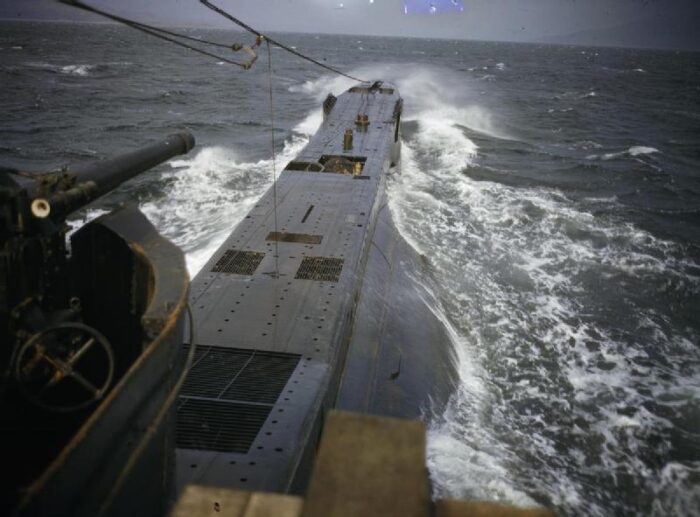
HMS Tribune’s deck awash, color photo, AWM coll.
The British submarine campaign against Germany was very specific as no blockade was profitable, Germany being mostly autonomous and only dependent on Baltic and land routes (notably USSR prior to the summer of 1941). So the T class preyed on rare vessels spotted in the North Sea, heavily mined. These were long, dangerous and often fruitless patrols.
On 10 September 1939 Triton spotted another submarine, challenged her, got no answer and fired two torpedoes, sinking her. Unfortunately this was HMS Oxley, first British submarine lost in the war. Why she did not answered remained linked to the apparent lack of watchful eyse this night. In any case, just two crew surviving the attack. Triumph soon almost sank too, hitting a mine on 26 December 1939 but survived, repaired in Rosyth.
They had better luck from April 1940 whe the Norwegian campaign commenced, which brought opportunities: On 8 April 1940, Triton fired but missed Blücher and Lützow. 2 days later the sank three troopships. Truant hit also the cruiser Karlsruhe. But some were also lost nor long after, Thistle by U-4 on 10 April, Tarpon by Q-ship Schiff 40/Schürbek on 14 April.
Next, T class established patrols in the strategic Bay of Biscay (the ‘Iron Ring’) from July 1940 as the battleof britain took place. Occupation of French Atlantic ports now allowed valuable kriegsmarine assets to be based on the coast in 1941.
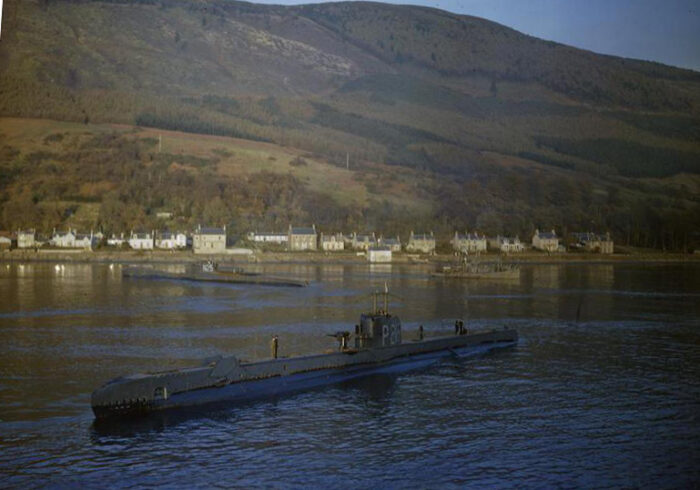
HMS Seadog (foreground) and Thunderbolt in Holy Loch, Scotland.
Then the Mediterranean started from September: On 15 December 1940, Thunderbolt torpedoed Capitano Tarantini, one of the 14 Axis submarines sunk by T-class collectively. On 5 July 1941, Tigris sank Michele Bianchi. Triton class also patrolled during the infamous ‘Channel Dash’, February 1942. Triton class targeted the the Italian Regia Marina, which trained a lot in ASW warfare and had a good sonar the ecogoniometro (ECG) mounted in many escort vessels, including the excellent Gabbiano, small VAS and many others. Mines was used as an art form where it matters and took a fair shere of T class subs as well. In fact the Italians gained an ASW tally comparatively higher than Germany or Japan and it shows in the losses of all British types.
In addions waters were mostly calm, shallow, and clear waters so that aviation could spot them with ease from the air, even well submerged, whereras shallow waters made ineffective the deep diving abilities of the large T class. But they enjoyed far greater endurance on this theater compared to the smaller S, V, U types. They operated from Alexandria and Gibraltar and could cross mid-way through the central Mediterranean and back with ease.
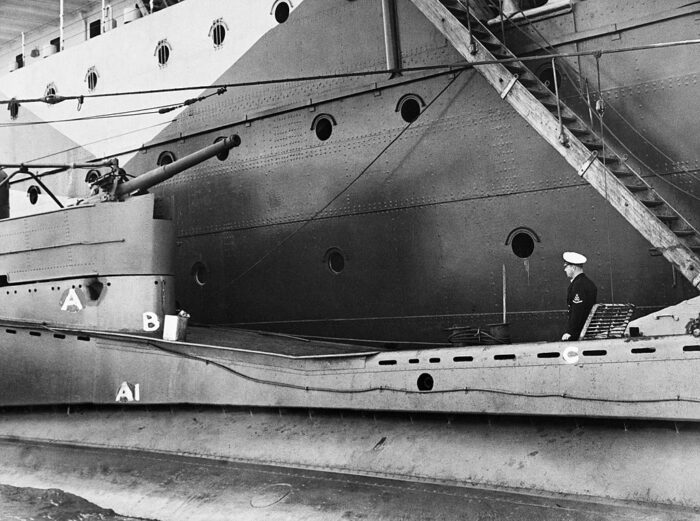
Damage assessment of HMS Thresher after a misidentification and air attack in 1942
Design to sink warships, the Triton class spent much time hunting down Axis convoys to North Africa and only when Malta had enough aviation to chase off axis patrollers and do reconnaissance and attacks, rhis “blind spot” was covered by British submarines. As aviation was always a danger, they stayed surfaced to recharge only at night and sailed at persicope depht most of the time, at slow speed. 13 T-class were lost in this theater, 50% to mines. But they did well like Turbulent sinking over 90,000 tons of Axis shipping. J. W. Linton of Turbulent was awarded one of the four Victoria Crosses (VCs) for all classed, and for Mediterranean campaign. Thrasher and Torbay (for a daring raid into Corfu) as well.

From Pinterest, all groups profiles
Of the Triton class, only Truant and Trusty were ordered to Singapore but were underway when it fall and they ended based in Ceylon with the surviving Dutch submarines for an Indian Ocean campaign against IJN communications lines in the east indies. They also were on faction during the Indian Ocean Raid. Truant sank two IJA transports. By late 1943 the situation changed, but successes awaited still Group II boats. There were few targets of opportunity in the area, but the all Group III and most Group II surviving were found more adapted to far Eastern operations.
Career of The T class
 HMS Triton
HMS Triton

HMS triton was laid down on 28 August 1936 at Vickers Armstrong, Barrow-in-Furness, launched on 5 October 1937, commissioned on 9 November 1938. Assigned to the 2nd Submarine Flotilla by late August 1939, she was deployed at Dundee and Blyth. The day the war started she was on patrol on the Obrestad line, off Norway, on 24 August 1939. On 19:55 on 10 September Triton was surfaced off the Obrestad Light in a slow zigzag patrol while charging batteries. Lt. Cdr Steel leeft the post after placed lookouts on the bridge with the officer of the watch. At 20:45, he was called to the bridge when was spotted something, and orcered torpedo tubes 7 and 8 prepared for firing, until a submarine was recoignised low in the water.
The signalman sent three challenges and waited several minutes, go no answers. Captain Steel wondered if this could be HMS Oxley, off her next assigned patrolling area. No study of the silhouette, could give up the type. Then three green rifle-grenade flares were fired and 15 second s were waited still without answer, thus Steel believed he had an U-Boat facing him and ordered to place the boat for a volley, firing tube 7 and three sec. later tube 8. An explosion was heard and he ordered full speed ahread to see the wreck and confirm the kill. However the Aldis lamp only revealed three men amid oil and debris, duly brought on board and interrogated, with quite a surprise.
These were Oxley’s men on watch on the bridge, Lt. Commander H.G. Bowerman (CO) Able Seaman Gluckes, lookout but Lt. F.K. Manley disappeared. The Board of Enquiry concluded this was ot Steel’s fault as he was reasonable in his attempts. Not only Oxley was out of position and bizarrely it seems none on the men on watch saw tTriton’s signals. This forst T class success was however still a “friendly fire.” camouflaged as an accidental explosion to keep morale and postwar, this was changed to a collision with Triton, and only revealed in the 1950s.
Next Triton patrolled the Baltic waters and near the Skagerrak, she caught on 8 April the cruisers Blücher, Lützow and Emden off Skagen, fired ten and missed. On 10 April 1940, she sank the steamers Friedenau, Wigbert, andpatrol vessel Rau 6, all in the Kattegat.
Next her Mediterranean campaign commenced, based from Alexandria. While in the Gulf of Genoa, Lieutenant Watkins tried to enter Savona, spotted and claimed a supply ship at anchor (8,000-ton, unconfirmed). As no other vessel was worth a torpedo, her surfaced and started shelling a large factory and gas works before departing. He notably damaged the Cieli Electric Station.
On 28 November 1940, Triton left Malta for the southern Adriatic and on 6 December, the admirakty was informed of the sinking of the merchant Olimpia attributed to Triton bnut the latter never went back to comunication and was not heard. It is now presumed lost on 18 December and Olimpia survived being towed to port whereas the Regia Marina Triton sunk by the torpedo boats Confienza or Clio, the British stating mines in the Strait of Otranto instead.
 HMS Thetis/Thunderbolt
HMS Thetis/Thunderbolt
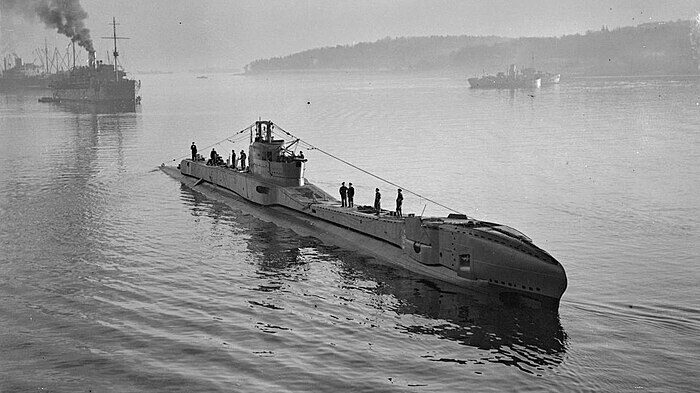
HMS Thetis was built at Cammell Laird in Birkenhead, launched on 29 June 1938 and after completion her forward hydroplanes jammed. Her trials were completed in Liverpool Bay under Lt. Commander Guy Bolus and diving trials with the tug Grebe Cock. She carried 59 men and Yard’s technical observers for 103 total. First dive was attempted at 14:00 on 1 June 1939 but she too light and checks were made, notably flooding the tubes, done by Lt. Frederick Woods (torpedo officer), which opened the test cocks. But those on tube 5 were blocked by enamel paint. Plus there was confusing in the layout of the bow cap indicators, arra,ged vertically placing 5 at the bottom while its “Shut” position on the dial mirrored tube 6 above. Long story short, the the inner door of the tube was opened and water rushed inside so violently there was no time to close the compartment.
The whole submarine hit the seabed 150 ft (46 m). Woods, amazingly, survived to tell the tale and maintained his version all his life (all indicators “Shut”). At least an indicator buoy was released with its smoke candle fired indicated to the tug at 16:00 that something went wrong, contacting HMS Dolphin at Gosport. The rescue started. Her stern remained surfaced, with Frederick Woods, Captain Harry Oram and Leading Stoker Walter Arnold and Cammell Laird Fitter Frank Shaw escaping in time. The others were overcome by carbon dioxide poisoning, massive atmospheric pressure and 20 hours before the evacuation started. 99 were lost, including 26 Cammell Laird workers, 15 officers, Vickers-Armstrong employees, caterers and the Mersey pilot. She was spotted late by the destroyer Brazen.
The survivors used the 4-men large aft escape chamber but other escapees drawned.
The Admiralty successfully blocked the disclosure of the contract and it was accepted by judges. The case draw the urge for better ergonomics.
The Liverpool & Glasgow Salvage Association was commissioned for the salvage during which a diver died from “the bends” on 23 August 1939. On 3 September, just towed, Thetis was grounded ashore at Traeth Bychan in Anglesey and bodies were extracted for the naval funeral, with full honours.
An HMS Thetis memorial was later erected at Woodside in Birkenhead and another to Maeshyfryd Cemetery in Holyhead in 1947. After being repaired to avoid the bad luck associated with such event, she was renamed HMS Thunderbolt, under the command of Lt. Cdr. Cecil Crouch. She was rushed into service and spent 18 months in the Atlantic, Bay of Biscay in which she spotted and sank on 15 December 1940 the Italian submarine Capitano Tarantini, en route to the recently axis submarine base of Bordeaux (BETASOM).
Later in 1942, Thunderbolt and Trooper, P311 was modified to carry two “Chariots” and crews to target Axis shipping in harbour, transferred by December 1942.
She took part in Operation Principal by December 1942, Thunderbolt being assigned Cagliari, but this was not a success. P311 was lost at La Maddalena.
Next, she was assigned to Palermo harbour in January 1943, and more successful and on 2–3 January, mined sank the incomplete light cruiser Ulpio Traiano and freighter SS Viminale.
Next raid was in Tripoli harbour on 18 January, to hit any prepared blockships priot to the occupation by the 8th Army.
On 20 February 1943 she shelled the Albanian sailboat Villanzen Veli off Bari but was chased off by the auxiliary cruiser Brindisi and a coastal battery.
She was sunk on 14 March 1943 off Sicily, hunter down by the Gabbiano class corvette Cicogna after being detected her depth charged under 1,350 m (4,430 ft) withh all hands.
 HMS Tribune
HMS Tribune

Tribune, built at Scotts, Greenock, commissioned 17 October 1939, was part of the 1st group, T class submarines and she started the war with North Sea operations, attacking an unidentified German submarine later revealed as U-56, German tanker Karibisches Meer, German merchant Birkenfels but missed all. Mediterranean: She hit and damaged the French merchant Dalny, beached and gunned. She damaged the German tanker Präsident Herrenschmidt, Italian merchant Benevento, missed.
She was taken as base for the 1943 British wartime propaganda film “Close Quarters” impersonating “HMS Tyrant” in the North Sea. She survived the war and sold for scrap in July 1947 (Thos. W. Ward in Milford Haven).
 HMS Trident
HMS Trident
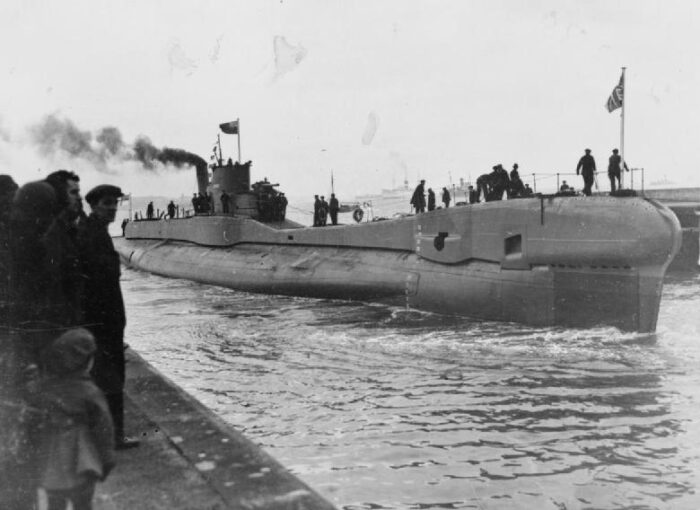
Trident built at Cammell Laird, commissioned 1st October 1939, and in May 1940, she operated in Kors fjord Norway, spotting and sinking a German supply ship. From 1941 to mid 1943 she stayed in the North Sea, sinking the German merchants Edmund Hugo Stinnes 4, Ostpreußen, Donau II, Hödur and Bahia Laura, the tanker Stedingen and auxiliary submarine chaser UJ 1213. She attacked, damaged the Cläre Hugo Stinnes and Levante, missed the Palime, Wandsbek, Pelikan and Altkirch, oiler Dithmarschen, hospital ship Birka, minesweeper depot ship MRS 3 (better known as Bali) and U-31. From her Polyary based in Russia, she spotted but missed U-566. She also spotted, engaged, but mostly missed the Prinz Eugen and Admiral Scheer on 23 February 1942. Prinz Eugen was hit in the stern but she survived. Her unusual mascot was a… young reindeer presented as gift by the Russians in August 1941, named “Pollyanna” which once ate a few navigations maps. She ended in a local zoo, still reacting to the sound of whistle.
In the Mediterranean, Trident sank five sailing vessels, damaged the Italian merchant Vesta, German GA 41, attacked the auxiliary UJ 2202. She missed the Italian merchant Agnani and French passenger/cargo ship Cap Corse. She was reassigned to the far east and arrived in Colombo by mid 1943. She sank a Japanese sailing vessel, a Daihatsu landing craft (bu gunfire off Batu islands, Indonesia) but missed the cruiser Kashii. Back home she was sold for scrap on 17 February 1946, BU in Cashmore, Newport.
 HMS Triumph
HMS Triumph
Triumph built by Vickers, Barrow-in-Furness, launched 1938, and commissioned by May 1939. She operated from Dundee and Blyth, and on 26 December 1939, hit a German mine, loosing a 18 feet (5.5 m) section of her bow and had her pressure hull damaged, but torpedoes did not detonate. She was repaired at Chatham until 27 September 1940 and was sent to the Mediterranean in early 1941, sinking the Italian merchants Marzamemi, Colomba Lofaro, Ninfea, Monrosa, auxiliary patrol vessels V 136, Valoroso, V 190, V 137, the tug Dante de Lutti, salvage vessel Hercules, German merchant Luvsee, Greek sailing vessels Panagiotis and Aghia Paraskevi, damaged the Italian armed merchant cruiser Ramb III, tankers Ardor and Poseidone, merchant Sidamo, German merchant Norburg and satrted to be used for covert operations. She was tasked to carry commandos for Operation Colossus, cancelled. By December 30, 1941 she landed agents at Antiparos in Greece but failed to pick up agents on 9 being lost by a mine, sinking with all hands, adn her wreck was rediscovered in June 2023 by Kostas Thoktaridis under 203 metres, confirming the mine.
 HMS Taku
HMS Taku
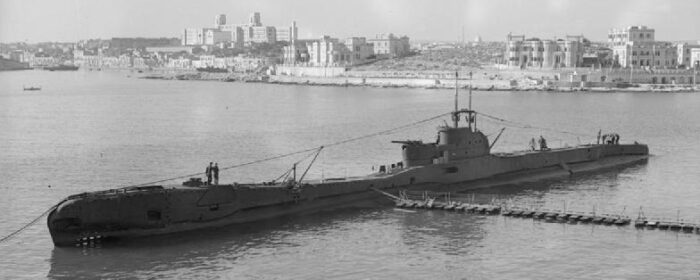
Taku was laid down on 18 November 1937, launched 18 May 1938, commissioned 3 October 1940. In April 1940 she fired on HMS Ashanti bu mistake but missed. In May she attacked a German convoy, damaged the torpedo boat Möwe, and by November, missed the tanker Gedania. In the Mediterranean by 1941, she sank the Italian merchantmen Cagliari, Silvio Scaroni, passenger/cargo ship Caldea, German munitions transport Tilly L. M. Russ, Italian auxiliary minesweeper Vincenso P., Italian tankers Arca and Delfin, Greek sailing vessels Niki, Lora and another. She missed the German merchant ship Menes, Italian tanker Cerere. She was repatriated to the Scandinavian coast in 1944, sank the German merchantmens Rheinhausen, Hans Bornhofen, badly damaged Harm Fritzen. In March she missed the Kriegsmarine transport Moshill. She hit a mine in April 1944, badly damaged, but limped to port and was not repaired. She was sold in November 1946, BU in South Wales.
 HMS Tarpon
HMS Tarpon
Tarpon was laid down on 5 October 1937, launched on 17 October 1939 and Commissioned on 8 March 1940 and had a short career in the North Sea. She left Portsmouth on 5 April 1940 for Rosyth with HMS Severn and sailed for Norway. The 10th she was assigned her first patrol route, but could not be reached again. By combining British and German records it seems she as detected and engaged by Schiff 40, a Q-ship also known as Schürbek, attacked her but missed and the latter reteliated with depth charges. The action was decribed by the Germans taking place in the morning and a second pattern brought wreckage to the surface, she stayed ald left at 05:00 the next morning. In Britain, Tarpon was reported overdue on 22 April 1940. The wreck was found and identified near Thyborøn by Danish commercial diver Gert Normann Andersen from JD-Contractor with British marine archaeologist Dr Innes McCartney, in March 2016 under 40m of water. There was a live TV program about her on 28 August 2016. Her two torpedo tubes were empty and damage confirmed depth charges.
 HMS Thistle
HMS Thistle

Thistle was Laid down on 7 December 1937, Launched on 25 October 1938, Commissioned on 4 July 1939. She was part of the 2nd Submarine Flotilla and on 26-29 August 1939 deployed from Dundee and Blyth under Lt. Wilfrid Frederick Haselfoot. Her first patrol patrol off Stavanger was motiovated by intel about the invasion of Norway being imminent. On 10 April she sailed there after her previous patrol, wirh two torpedoes remaining after missing an U-boat. She was then ordered off Skudenes and no contact was made again.
It seemed that U-4 (a small Type IIa), that she previously attacked, sighted her surfaced by night and torpedoed her as confirmed by her logs postwar. Thistle attack happened at 16:04 hours on 9 April 1940, firing six torpedoes and missing, as reported via radio.
U-4 spotted the wakes and evaded by crash diving, and evolved, surfaced, search for her attacker ahnd found her later surfaced, charging batteries. She took position at 02:13 hours on 10 April and fired two torpedoes, a G7a which missed and a recent magnetic G7e which hit. it happened off Skudenes. Her wreck was rediscovered by the Norwegian Institute of Marine Research, spring 2023 under 160 meters and conformed in October 2023.
 HMS Tigris
HMS Tigris
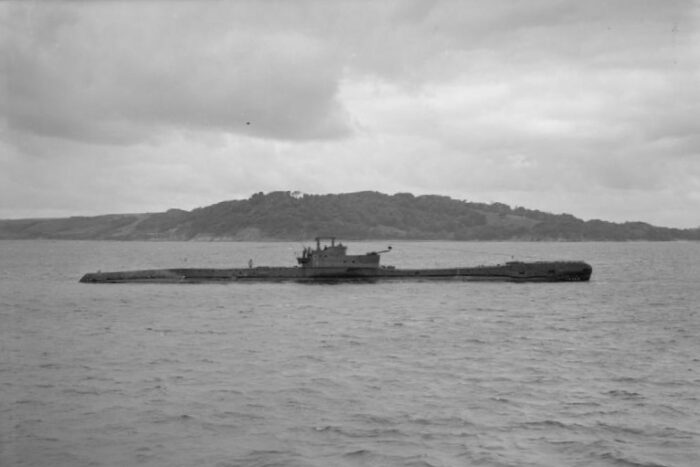
Tigris was Laid down on 11 May 1938, launched on 31 October 1939 and Commissioned on 20 June 1940. She operated in the Bay of Biscay from July 1940, under Howard Bone, sank the French fishing vessels Sancte Michael, Cimcour, Charles Edmond and Rene Camaleyre, merchantmen Jacobsen and Guilvinec, German tanker Thorn and attacked but missed among others U-58 On 5 October 1940, as well as two Italian submarines from Bordeaux, Reginaldo Giuliani and Maggiore Baracca.
On 5 July 1941 she sank Michele Bianchi 150 nm off the Gironde estuary and was reassigned to the north sea by mid-1941. Off Finnmark, she sank the Norwegian Haakon Jarl and Richard With. Next, reassigned to the Mediterranean, from late 1942, on 6 December, she sank the Italian submarine Porfido, with commander George Colvin, later awarded the DSO. On 21 January 1943, she sank the Italian merchant Citta di Genova, in the Strait of Otranto.
She left Malta on 18 February 1943 for Naples and on 22 February attacked the merchant Teramo, presumably as she was never head of again. She was last sighted at 0730, 24 February, 39 miles from Capri. She was claimed by the German submarine chaser UJ 2210 (Otto Pollmann), escorting a convoy off Capri, having a contact and making three depth charge attacks, a third bringing oil to the surface, and anothr attack creating a huge air bubble. Tigris was overdue to Algiers on 10 March 1943 and is believed sunk on 27 February.
 HMS Triad
HMS Triad
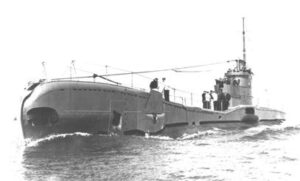 HMS Triad was laid down on 24 March 1938, launched on 5 May 1939 and commissioned on 16 September 1939. She patrolled the north sea at the start of the war, and by April 1940 while off Norway, she sank the German troop transport Ionia and missed the German depot ship Tsingtau.
HMS Triad was laid down on 24 March 1938, launched on 5 May 1939 and commissioned on 16 September 1939. She patrolled the north sea at the start of the war, and by April 1940 while off Norway, she sank the German troop transport Ionia and missed the German depot ship Tsingtau.
She was redeployed in the Mediterranean and on 9 October 1940 departed from Malta to the Gulf of Taranto, then bound to Alexandria but was overdue there by 20 October. Now it was establmished she was torpedoed and sunk with all hands on the night of 14/15 October by the Italian submersible Enrico Toti which was instead being attributed HMS Rainbow. At the time it happened she was under command og Lt.Cdr. G.S. Salt.
As reconstructed from postwar Italian logs it happened at 01:00 on 15 October 1940, when Enrico Toti sighted a large submarine about 1,000 metres (3,300 ft) port of her, and it seemd Triad spotted her also both starting a deadly dance to be in torpedo position. It was claimed the British opened fire first (gunfire) but missed and a torpedo which Enrico Toti avoided, then closed at top speed, and started to fire, by Gun and MG-fired, compelling the British crew to leave the deck and run for cover. As triad started to dive, Enrico Toti fired a single torpedo which hit her, after lainding already two 120 mm hits. This happened south-west of Calabria in about 30 minutes, and later narrated by Famous Italian writer Dino Buzzati which made interviews of the crew and became a celebtriy for his report live at the Battle of Cape Matapan. The story was published in October 1940. Confusion with Rainbow was cleared by historians in 1988, crossing data and logs, but her wreck was not found.
 HMS Truant
HMS Truant
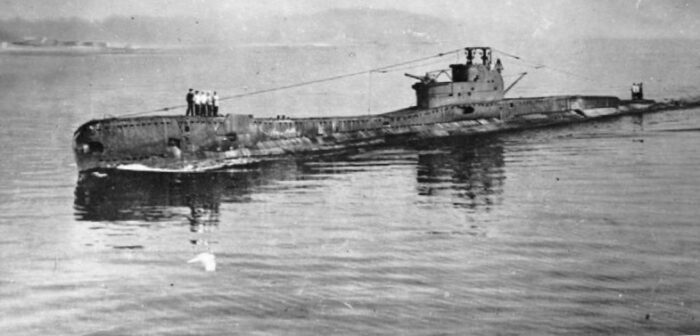
HMS Truant was laid down on 24 March 1938, launched on 5 May 1939 and commissioned on 31 October 1939. In March 1940 off Norway she damaged KMS Karlsruhe off Kristians and, and she was latter scuttled by the TB Greif. Truant later attacked the British merchant Alster but missed. She intercepted the German merchant Tropic Sea in the Bay of Biscay, recaptured 8,000 tons of wheat and the POW captain and 22 survivors of SS Haxby sunk earlier by the raider and the Norwegian crew. Truant wa smistook and torpedoed, missed, by the River-class submarine Clyde.
She was sent to the Mediterranean in May 1940, and sank many ships, such as the Italian merchant vessels Providenza, Sebastiano Bianchi and Multedo, tankers Bonzo and Meteor, auxiliary submarine chaser Vanna, passenger/cargo ship Bengasi, German merchantman Virginia S. and damaged the tanker Prometeo, torpedo boat Alcione (later total loss) but missed the merchants Utilitas, Silvia Tripcovich, Bainsizza and Arborea, tanker Labor, German merchantman Bellona.
She was then reassigned in early 1942 for the Far East, taking part in the Battle of Badung Strait, spotting the Japanese covering force, missed the cruiser Nagara, sunk the merchants Yae Maru and Shunsei Maru in the Malacca Strait, missed a large liner (hospital markings, possible Hikawa Maru) and destroyed by gunfire the Japanese army cargo ship Tamon Maru No.1 on her final patrol in late 1942 engine trouble.
Back to home waters for repairs and refits from December 1942 until May 1943, she was used for training and made a patrol to find Tirpitz but was soon ordered back to the Far East, marred by repairs after engine troubles. She stayed in local waters as trials ship for 1945, sold on 19 December 1945 but wrecked in December 1946 en route to the shipbreakers.
 HMS Tuna
HMS Tuna
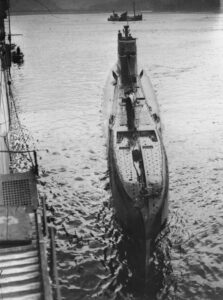 HMS Tuna was laid down on 13 June 1938, launched on 10 May 1940 and commissioned on 1 August 1940. Tuna sank the 7,230-ton merchantman Tirranna, on 22 September 1940 (captured by the German armed merchant cruiser Atlantis in the Indian Ocean), 87 went with her. She later sank the German catapult ship Ostmark and French tug Chassiron, but also the German submarine U-644 and missed U-302 and Italian submarine Brin as well as the German tanker Benno (also Atlantis capture).
HMS Tuna was laid down on 13 June 1938, launched on 10 May 1940 and commissioned on 1 August 1940. Tuna sank the 7,230-ton merchantman Tirranna, on 22 September 1940 (captured by the German armed merchant cruiser Atlantis in the Indian Ocean), 87 went with her. She later sank the German catapult ship Ostmark and French tug Chassiron, but also the German submarine U-644 and missed U-302 and Italian submarine Brin as well as the German tanker Benno (also Atlantis capture).
In January 1941 with her sister HMS Snapper they captured and took as prize the French minesweeper La Capricieuse to Bishop Rock but Snapper left, later presumed lost. Tuna chased on U-boatfor an hour, fired her deck gun and damaged her conning tower, the latter returned fire, no damage. She withdrawn as reinforcements arrived. By February 1942 she sailed to Trondheim with HMS Trident, protecting a troop convoy. On 30 November 1942, under Lt-Cdr Dick Raikes (DSO,) she left Holy Loch in Scotland for a covert operation with 12 Royal Marines swimmer canoeist commandos sneaked into Gironde estuary (Operation Frankton, attack on Bordeaux harbour) but was delayed by bad weather and a minefield and surfaced a day late 10 miles (16 km) from the mouth. During the canoe launch was was damaged, but the remainder went on and paddled 60 miles up the Gironde into Bordeaux. This was was a success which costed dearly, only Corporal Bill Sparks and Major Herbert Hasler surviving. Thi s experiment led to the formation of the Special Boat Service. The story led to the film the “Cockleshell Heroes”.
She performed four more war patrols on 18 November 1943 and sank no less than three U-boats making Lt. D. S. R. Martin, a recipient of the DSO with two bars with others awarded to Lt (E) N. Travers, Chief Petty Officer William J Stabb and Leading Seaman Dominic “Bommy” King.
No logs for the remainder of her service. In August 1945, she attended to enter Rotterdam in advance of the cruiser HMS Bellona and destroyers Garth and Onslow and the Free Dutch T-class Dolfijn and Zeehond. She sold for BU 19 December 1945.
 HMS Talisman
HMS Talisman
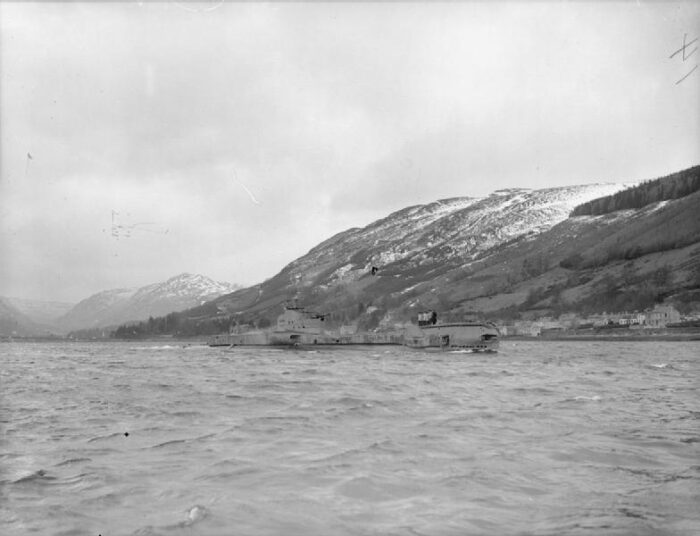
HMS Talisman was laid down on 27 September 1938, launched on 29 January 1940 and commissioned on 29 June 1940. Early in her service she captured the French fishing vessel Le Clipper. In British service she was used to observe U-boat movements off the Gironde estuar and ended later in Falmouth. She later torpedo-missed HMS Otus, mistaken. She sank two sailing vessels and the Vichy-French liner Théophile Gautier and Italian merchant Calitea, German merchant Yalov, damaged the merchant Salzburg, missed the Italian merchant Lauretta, heavily depth charged by the TB Libra. She left Gibraltar on 10 September 1942f for her last mission, carrying supplies to Malta, due on 18 September. She reported a U-boat off Philippeville in Algeria on 15 September underway, where was sent a Sunderland of 202 Sqn, which caught and sank the Italian submarine Alabastro. Talisman is presumed sunk by an Italian mine off Sicily of by surface forces on 17 September, her wreck was never found.
 HMS Tetrarch
HMS Tetrarch
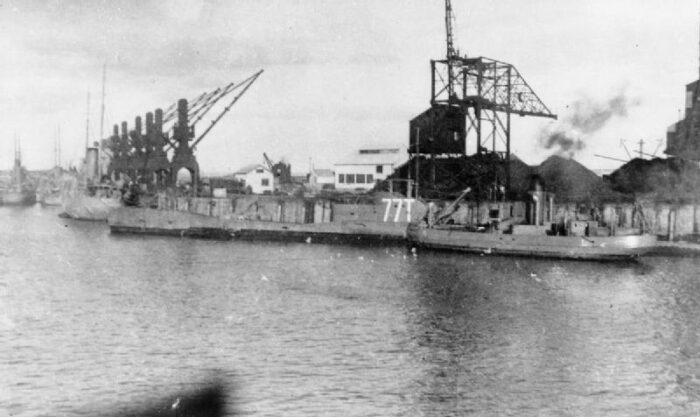
Tetrarch was laid down on 24 August 1938, launched on 14 November 1939 and commissioned on 15 February 1940 and the only T class ever completed with a minelaying equipment. In Home waters, first success was in May 1940 when sank the the sub-chaser UJ B in the Skagerrak. She sank the Danish fishing vessel Terieven, German tanker Samland, captured the Danish trawler Emmanuel and was reassigned to the Mediterranean in late 1940. She sank the Italian merchants Snia Amba, Giovinezza and Citta di Bastia, tanker Persiano, sailing vessels V 72, V 113 and Nicita, Greek sailing vessel Panagiotis Kramottos, damaged the German merchant Yalova and missed the Greek tanker Olympos.
She sailed to Malta on 26 October 1941 and departed for a refit back home bound for Gibraltar. but failed to arrive on 2 November, overdue, likely lost to a minefield. She still communicated on Monday 27, presumed sunk off Capo Granditola in Sicily by late October 1941. Wreck never found.
 HMS Torbay
HMS Torbay
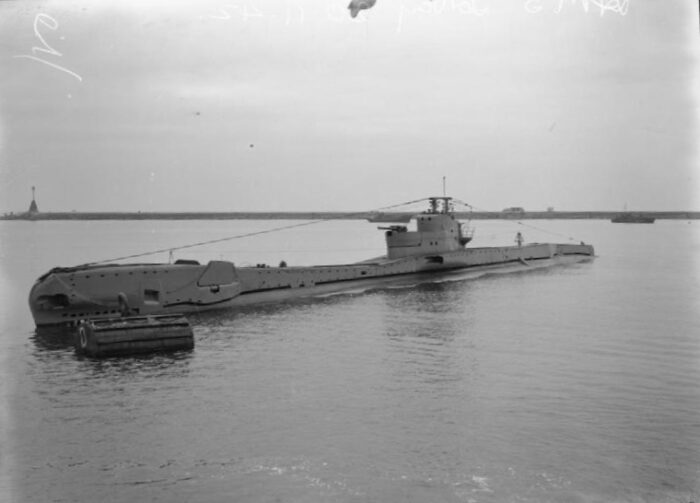
HMS Torbay was built at Chatham, laid down on 21 November 1938, launched on 9 April 1940 and commissioned on 14 January 1941. By March 1941 she left Portsmouth on her first patrol, trying to ambush Scharnhorst and Gneisenau heading for Brest after their sortie in the North Atlantic. She missed them and was ordered to Gibraltar, then 1st Flotilla at Alexandria.
For 12 months, she sank many ships and the Italian submarine Jantina as well as taking part of special operations.
Probably the best known was around Crete: Her mission was to surface bby night and evacuate Allied stragglers still roaming free after Crete surrendered to the Germans on 1 June. On 22 August 1941, she was found carrying 130 British and Anzacs to Alexandria, making a record. Commander Anthony ‘Crap’ Miers (VC) made it a ritual to salute Vichy French sailors aboard French ships at anchor in Alexandria every time he entered the port, with the crew assembled on deck, dropping trousers, ‘mooning’ them.
In July 1941 she was accuded twice of alleged war crimes, firing on axis troops swimming in the water, as written in the logs. He was strongly word reprimanded, but kept attacking Axis convoys, on 10 June 1941 off the Dardanelles, making a hit on the Italian tanker Utilitas (dud) and hit on tanker Giuseppina Ghirardi (sank), then on 12 August 1941 west of Benghazi on the Bosforo and Iseo (missed) and heavily depth charged..
By November 1941 he was tasked with landing commandos (Geoffrey Keyes) in Operation Flipper, not a success. On 15 December 1941 he sank the ex-Italian German merchant Sebastiano Veniero off Methoni (Peloponnese), after being already hit by HMS Porpoise.
On 4 March 1942 in Corfu he spotted a destroyer and two 5,000 ton transports, hit the latter presumed sank but escape a heavy depth charge attack. Anthony Miers ws awarded the VC for his 17th patrol in the area. Back to Britain for a refit, HMS Torbay was in the Mediterranean by February 1943 under Lt. Cdr. Robert Clutterbuck for more successful patrols, and nearly sunk by the Q-ship GA 45 by October 1943, periscope sighted, depth charged. A night deck gun atack failed as she was spotted and fired at back. Fortunately GA 45 run out of DCs. Next in early 1945 she was ordered to the Pacific Far East, arriving in May 1945 under Lt. C.P. Norman, sinking notably two Japanese sailing vessels, a coaster, damaged another.
She was sold for BU on 19 December 1945, scrapped March 1947.
Group II, 1939 war emergency Program
 HMS Tempest
HMS Tempest
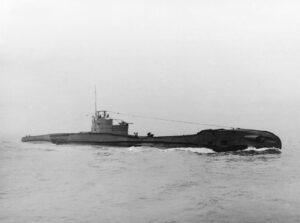 She was laid down by Cammell Laird & Co Limited in Birkenhead on 6 June 1940, Launched on 10 June 1941 and commissioned on 6 December 1941 with the pennant number N86. She saw service the Mediterranean theatre. Tempest was sunk by the Italian Spica-class torpedo boat Circe on 13 February 1942. Full logs on uboat.net
She was laid down by Cammell Laird & Co Limited in Birkenhead on 6 June 1940, Launched on 10 June 1941 and commissioned on 6 December 1941 with the pennant number N86. She saw service the Mediterranean theatre. Tempest was sunk by the Italian Spica-class torpedo boat Circe on 13 February 1942. Full logs on uboat.net
 HMS Thorn
HMS Thorn
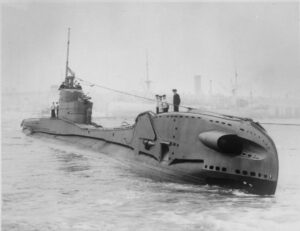 Thorn was laid down on 20 January 1940 at Cammell Laird, Launched on 18 March 1941 and commissioned on 26 August 1941 under the pennant number N11. By late 1941 she sank the German tanker Campina, Italian tanker Ninuccia, and her best success, the Italian submarine Medusa. Later she sank the Italian auxiliary patrol vessel AS 91 (Ottavia) and Italian transport ship Monviso. She later attacked an Italian convoy in the central Mediterranean but was not in good position and missed. Her luck turned out when she was sunk by the Italian Orsa-class torpedo boat Pegaso on 6 August 1942. Pegaso escorted the steamer Istria from Benghazi and was off southern Crete when she spotted aircraft in escort that machine-gunned something at the surface far away. She moved in to investigate and four minutes later picked up a sonar contact and spent hours and no less than seven attacks until the contact was was lost but no confirmed kill. Thorn failed to return from the patrol, believed lost in this attack, declared overdue on 11 August 1942.
Thorn was laid down on 20 January 1940 at Cammell Laird, Launched on 18 March 1941 and commissioned on 26 August 1941 under the pennant number N11. By late 1941 she sank the German tanker Campina, Italian tanker Ninuccia, and her best success, the Italian submarine Medusa. Later she sank the Italian auxiliary patrol vessel AS 91 (Ottavia) and Italian transport ship Monviso. She later attacked an Italian convoy in the central Mediterranean but was not in good position and missed. Her luck turned out when she was sunk by the Italian Orsa-class torpedo boat Pegaso on 6 August 1942. Pegaso escorted the steamer Istria from Benghazi and was off southern Crete when she spotted aircraft in escort that machine-gunned something at the surface far away. She moved in to investigate and four minutes later picked up a sonar contact and spent hours and no less than seven attacks until the contact was was lost but no confirmed kill. Thorn failed to return from the patrol, believed lost in this attack, declared overdue on 11 August 1942.
 HMS Thrasher
HMS Thrasher
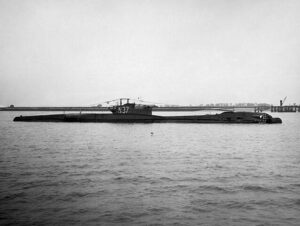 Thrasher was laid down at Cammell Laird on 14 November 1939, launched on 28 November 1940 and commissioned on 14 May 1941 under the pennant number N37. She torpededoed and damaged the French fishing vessel Virgo Fidelis in the Bay of Biscay while transiting to the Mediterranean (total loss). She later sank three Greek sailing vessels, the Italians Esperia, Attilio Deffenu, Fedora, Gala, Penelope, Lero, Sant’Antonio and Padenna, German Atlas, Italian tugs Pilo and Roma and her best kill, the Italian aviso Diana. She missed the transport Ankara, German Arkadia, the barge F 184. In July 1942 she was bombed in error by a Swordfish off Port Said (damage, one month repair). She later sank 20,000 long tons (22,000 short tons; 20,000 t) of enemy shipping. Later two men earned a VC after an air attack on 16 February 1942 north of Crete, when they managed to defuse and clear an unexploded bomb clear over her side. Next she was sent to the Far East in early 1945, sank 20 sailing vessel, four coasters until V day. Back home she was sold for BU on 9 March 1947.
Thrasher was laid down at Cammell Laird on 14 November 1939, launched on 28 November 1940 and commissioned on 14 May 1941 under the pennant number N37. She torpededoed and damaged the French fishing vessel Virgo Fidelis in the Bay of Biscay while transiting to the Mediterranean (total loss). She later sank three Greek sailing vessels, the Italians Esperia, Attilio Deffenu, Fedora, Gala, Penelope, Lero, Sant’Antonio and Padenna, German Atlas, Italian tugs Pilo and Roma and her best kill, the Italian aviso Diana. She missed the transport Ankara, German Arkadia, the barge F 184. In July 1942 she was bombed in error by a Swordfish off Port Said (damage, one month repair). She later sank 20,000 long tons (22,000 short tons; 20,000 t) of enemy shipping. Later two men earned a VC after an air attack on 16 February 1942 north of Crete, when they managed to defuse and clear an unexploded bomb clear over her side. Next she was sent to the Far East in early 1945, sank 20 sailing vessel, four coasters until V day. Back home she was sold for BU on 9 March 1947.
 HMS Traveller
HMS Traveller
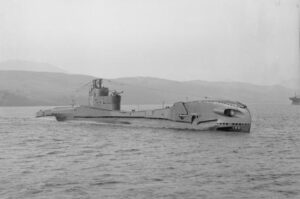 Traveller was Built at Scotts, Greenock, laid down on 17 January 1940, launched on 27 August 1941 and commissioned on 10 April 1942 under the pennant N48.
Traveller was Built at Scotts, Greenock, laid down on 17 January 1940, launched on 27 August 1941 and commissioned on 10 April 1942 under the pennant N48.
Sge was assigned to the Mediterranean, unsuccessful in most attacks buy claimed the Italian Albachiara, failed against Ezilda Croce, the cruiser Cattaro, tanker Proserpina and the TBs Castore and Ciclone. She left Malta on 28 November 1942 for intel and ambush the gulf of Taranto. After reconnaissance of Taranto harbour for a later “Chariot” torpedo attack (Operation Principal) she did not return, was reported overdue on 12 December. Lost, probably to Italian mines, on 4 or 12 December 1942.
 HMS Trooper
HMS Trooper
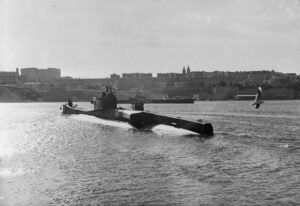 Trooper was Laid down at Scotts, Greenock on 7 May 1940, launched on 5 March 1942, commissioned on 29 August 1942 under the pennant N91. She had a short career in the Mediterranean: She spotted and sank the Italian tanker Rosario, as well as the Italian merchant ship Forli, and a sailing vessel, plus the Italian submarine Pietro Micca, her most famous kill. She also damaged two other ships but also made many unsuccessfully attacks, such as the merchant Belluno (French “Fort de France”). She also took Operation Principal, with chariots (human torpedoes) to rampage Palermo harbour.
Trooper was Laid down at Scotts, Greenock on 7 May 1940, launched on 5 March 1942, commissioned on 29 August 1942 under the pennant N91. She had a short career in the Mediterranean: She spotted and sank the Italian tanker Rosario, as well as the Italian merchant ship Forli, and a sailing vessel, plus the Italian submarine Pietro Micca, her most famous kill. She also damaged two other ships but also made many unsuccessfully attacks, such as the merchant Belluno (French “Fort de France”). She also took Operation Principal, with chariots (human torpedoes) to rampage Palermo harbour.
She sailed from Beirut on 26 September 1943 for her 8th War Patrol and headed for the Aegean Sea and Dodecanese islands. On 14 October she surfaced and threatened the Schooner Flotilla F8 off Alinda Bay in Leros. She failed to return on 17 October, but was stated “overdue” and after the delay ran out, presumed lost on German mines around Leros. That’s historians tend to believe for 80+ years that it until her wreck was discovered in the Icarian Sea in 2023. Germans logs stated she was sunk by Q-ship GA.45 on 15 October 1943 but on British side it was HMS Torbay, and she escaped unscathed.
The wreck of HMS Trooper was discovered under 253 metres (830 ft) in the Icarian Sea, north of Donousa island. She borke in three parts, probably with the force of an implosion, bow, mid-section, and stern. The most common reason now advanced is that she hit a German EMF mine (350 kgs/770 lb) of Hexanite. The search and discovery was the results of Greek researcher Kostas Thoctaridis. This discovery brought closure to families of all 64 crew member that went down with her. See also.
 HMS Trusty
HMS Trusty
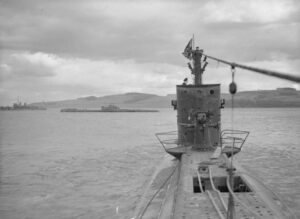 HMS Trusty was built at Vickers Armstrong, Barrow, laid down on 15 March 1940, launched on 14 March 1941 and commissioned on 30 July 1941, under the pennant number N45. She served in the Mediterranean and Pacific later in her career, as typical of her group. She trained in Scotland and on 6 September 1941 transitioned to the Med, Gibraltar. On 20 September she depatrted under command of Lt.Cdr. W.D.A. King, for her 1st war patrol in the Tyrrhenian Sea North of Sicily and provide cover for operation Halberd. On the 29th she attacked a schooner. On the 30th sept. she spotted a Vichy French hospital shop and surfaced sub at her bow, believed to be Italian, but she had to leave the area and sail to Malta for her second patrol. She spotted and convoy and attacked on 25 October, missed the Calino. She started her 3rd patrol in November, ordered off Cape Gheroghambo, Libya. She spotted but missed Antonio da Noli, Emanuelle Pessagno and Ugolino Vivaldi escorting the transport Bellona on the 28th. On 4 December 1941 she is often credited with the sinking of the transport Eridano (Italian, 3,586 GRT, 1912) but she was sunk by HMS Perseus.
HMS Trusty was built at Vickers Armstrong, Barrow, laid down on 15 March 1940, launched on 14 March 1941 and commissioned on 30 July 1941, under the pennant number N45. She served in the Mediterranean and Pacific later in her career, as typical of her group. She trained in Scotland and on 6 September 1941 transitioned to the Med, Gibraltar. On 20 September she depatrted under command of Lt.Cdr. W.D.A. King, for her 1st war patrol in the Tyrrhenian Sea North of Sicily and provide cover for operation Halberd. On the 29th she attacked a schooner. On the 30th sept. she spotted a Vichy French hospital shop and surfaced sub at her bow, believed to be Italian, but she had to leave the area and sail to Malta for her second patrol. She spotted and convoy and attacked on 25 October, missed the Calino. She started her 3rd patrol in November, ordered off Cape Gheroghambo, Libya. She spotted but missed Antonio da Noli, Emanuelle Pessagno and Ugolino Vivaldi escorting the transport Bellona on the 28th. On 4 December 1941 she is often credited with the sinking of the transport Eridano (Italian, 3,586 GRT, 1912) but she was sunk by HMS Perseus.
She was reassigned on 26 Dec. to the Pacific via Singapore where on 30 January 1942 she was damaged by splinters from near misses from Japanese bombing in Keppel Harbour. Later she sank the Japanese merchant cargo ship Toyohashi Maru on 4 June 1942, damaged the Japanese troop transport Columbia Maru on 18 November. On 4 Feb. 1943 she took part in operation ‘Alight’, infiltrating agents in French Indochina. On 11 Feb 1943 she claims the sinking of a 4000 tons merchant vessel in the Java Sea (unconfirmed). On 5 April 1943 she returned home. On 6 June 1943 about 300 nm West of Gibraltar under Lt.Cdr. E.F Balston she was rammed by the Spanish tanker Campeche (6,382 GRT 1934) while under 49 feet, having her T and persicopes damaged. She returned to Scotland and became a TS after repairs until 1945. She was sold for BU in January 1947, scrapped at Milford Haven in July 1947. More.
 HMS Turbulent
HMS Turbulent
 HMS Turbulent was built at Vickers Armstrong, Barrow. She was laid down on 15 March 1940, launched on 12 May 1941, commissioned on 2 December 1941 under the pennant number N98. She was easily one of the most successful of the T class in world war two. Sadly she was also sunk. Turbulent spent most of her career in the Mediterranean and claimed over 150,000 tonnes of shipping, 90K of which were verified postwar. She sank six Greek sailing vessels (Prodromos, Aghios Apostolos, Aghios Yonizov, Evangelista, Aghios Dyonysios and Aghia Traio), nine Italian merchantme (Rosa M., Delia, Bolsena, Capo Arma, Regulus, Marte, Vittoria Beraldo, Pozzuoli and San Vincenzo), three Italian sailing vessels (Franco, San Giusto, Gesù Giuseppe e Maria, Pier Delle Vigne) and her best kill, the Italian Navigatori-class destroyer Emanuele Pessagno. She also finishedoff the destroyer Strale, grounded near Cape Bon on 1 June 1942. She also sank the German ship Kreta, German auxiliary submarine tender Bengasi and Italian tanker Utilitas, damaged the Italian tanker Pozarica, Italian cargo ship Nino Bixio which carried 3,000 Allied POWs without proper indentification, contrary to the Geneva convention (336 killed). She also attacked an unidentified submarine off Fiume, damaged the Italian merchantmen Anna Maria Gualdi and Sestriere, German U-81 in two attacks, German transport Ankara, Italian armed merchant cruiser Ramb III in Benghazi harbour, small Italian passenger and cargo vessel Principessa Mafalda.
HMS Turbulent was built at Vickers Armstrong, Barrow. She was laid down on 15 March 1940, launched on 12 May 1941, commissioned on 2 December 1941 under the pennant number N98. She was easily one of the most successful of the T class in world war two. Sadly she was also sunk. Turbulent spent most of her career in the Mediterranean and claimed over 150,000 tonnes of shipping, 90K of which were verified postwar. She sank six Greek sailing vessels (Prodromos, Aghios Apostolos, Aghios Yonizov, Evangelista, Aghios Dyonysios and Aghia Traio), nine Italian merchantme (Rosa M., Delia, Bolsena, Capo Arma, Regulus, Marte, Vittoria Beraldo, Pozzuoli and San Vincenzo), three Italian sailing vessels (Franco, San Giusto, Gesù Giuseppe e Maria, Pier Delle Vigne) and her best kill, the Italian Navigatori-class destroyer Emanuele Pessagno. She also finishedoff the destroyer Strale, grounded near Cape Bon on 1 June 1942. She also sank the German ship Kreta, German auxiliary submarine tender Bengasi and Italian tanker Utilitas, damaged the Italian tanker Pozarica, Italian cargo ship Nino Bixio which carried 3,000 Allied POWs without proper indentification, contrary to the Geneva convention (336 killed). She also attacked an unidentified submarine off Fiume, damaged the Italian merchantmen Anna Maria Gualdi and Sestriere, German U-81 in two attacks, German transport Ankara, Italian armed merchant cruiser Ramb III in Benghazi harbour, small Italian passenger and cargo vessel Principessa Mafalda.
On 23 February 1943 in what became her last cruise, she sailed from Algiers for a patrol in the Tyrrhenian Sea and on 1 March she probably sank the steamer San Vincenzo. On 3 March she shelled and sank the Italian motorsailers Gesù Giuseppe e Maria and Pier Delle Vigne. On 12 March the ASW trawler Teti II sighted her periscope and attacked. It is assumed successful as Turbulent failed to respond to any further messages and was overdue on 23 March. Another hypothesis was a mine off Maddalena (Sardinia). Lt-cdr P K Kemp, RN worked with Admiral Fioravanzo by February 1959 to exclude this latter. The letter ended at the Ufficio Storico. Another hypothesis was an mistaken identidy and encounter with FFL French submarine Casabianca, on a attack reported on 6 March 1943 by the TBs Ardito off Punta Licosa (Naples). She had been already depth charged on over 250 occasions so her luck just ran out as admitted by most which crossed her crew.
John Wallace Linton, DSO DSC RN was posthumously awarded the Victoria Cross in May 1943.
Group III, 1940 war emergency Program
 HMS Tutankhamen (P311)
HMS Tutankhamen (P311)
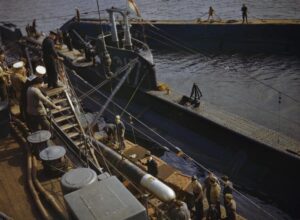 P311 was completed in August 1942 and joined the 10th Submarine Flotilla at Malta from November. She was lost with all hands between 30 December 1942 and 8 January 1943. She was probably underway to Maddalena in Sardinia, taking position as reported to intercept the two Italian heavy cruisers Gorizia and the Trieste, survivors of the Zara class gutted at Matapan. They are at that stage the most capable Italian cruisers still commissioned. The attack was to be using chariot manned torpedoes carried on the casing of P311. This was Operation Principal. P311 ent her her final signal on 31 December 1942, and was reported overdue on 8 January 1943 when she failed to return to base. The first hypothesis was she was sunk by Italian mines off Maddalena around 2 January 1943.
P311 was completed in August 1942 and joined the 10th Submarine Flotilla at Malta from November. She was lost with all hands between 30 December 1942 and 8 January 1943. She was probably underway to Maddalena in Sardinia, taking position as reported to intercept the two Italian heavy cruisers Gorizia and the Trieste, survivors of the Zara class gutted at Matapan. They are at that stage the most capable Italian cruisers still commissioned. The attack was to be using chariot manned torpedoes carried on the casing of P311. This was Operation Principal. P311 ent her her final signal on 31 December 1942, and was reported overdue on 8 January 1943 when she failed to return to base. The first hypothesis was she was sunk by Italian mines off Maddalena around 2 January 1943.
However her wreck was rediscovered by late May 2016 after a RN investigatiion close to Tavolara Island after a wreck was first reported by diver Massimo Domenico Bondone on 21 May 2016. Bondone identified her as P311, based on the two chariots still strapped to her hull. The 71 crew members aboard, including the chariot operators presihed on board due to suffocation. Indeed P311 was in good condition. Pictures were released showing that only the bow was seriously damaged in a way coherent with the explanation of a mine explosion.
 HMS Trespasser
HMS Trespasser
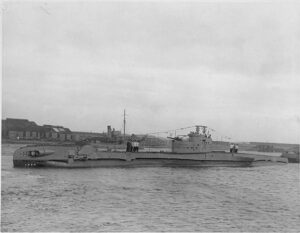 Built at Vickers P312 was laid down on 8 September 1941, launched on 29 May 1942 and commissioned on 25 September. She started service with the Mediterranean and by 1944 was moved to the Far East. She lad little kills. One was in the Gulf of Lyon, when she fired three torpedoes at a dead whale, mistaken for an enemy submarine and also failed to sink the German auxiliary patrol vessel Uj 6073 (ex-Nimeth Allah). But she sank the Italian auxiliary patrol vessel V8 (ex-Filippo), with gunfire. In the Far East, she acted with the British Pacific fleet, her only success was to torpedo and damage the Japanese auxiliary gunboat Eifuku Maru, off Burma. Postwar she continued to serve, unmodified, until sold for BU to Gateshead on 26 September 1961.
Built at Vickers P312 was laid down on 8 September 1941, launched on 29 May 1942 and commissioned on 25 September. She started service with the Mediterranean and by 1944 was moved to the Far East. She lad little kills. One was in the Gulf of Lyon, when she fired three torpedoes at a dead whale, mistaken for an enemy submarine and also failed to sink the German auxiliary patrol vessel Uj 6073 (ex-Nimeth Allah). But she sank the Italian auxiliary patrol vessel V8 (ex-Filippo), with gunfire. In the Far East, she acted with the British Pacific fleet, her only success was to torpedo and damage the Japanese auxiliary gunboat Eifuku Maru, off Burma. Postwar she continued to serve, unmodified, until sold for BU to Gateshead on 26 September 1961.
 HMS Taurus
HMS Taurus
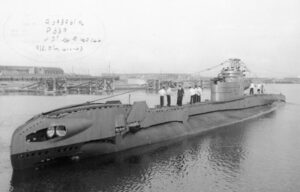 HMS Taurus was laid down on 30 September 1941, launched on 27 June 1942, commissioned on 3 November 1942 (P339). She was active in the Mediterranean 1942-44 and Pacific Far East until September 1945 wit the BPF. In the Mediterranean, she sank the Vichy French merchant Clairette, Spanish merchant Bartolo, Italian merchant Derna, French tug Ghrib and two barges, the Portuguese Santa Irene, Italian tanker Alcione C., Italian sailing vessel Luigi, and some 28 Greek sailing vessels, plus the Greek steamer Romano. She damaged two sailing ships, the Greek merchant Konstantinos Louloudis. She even engaged a Bulgarian cavalry unit by gunfire while bombarding a small port. In the Far East she sank the Japanese submarine I-34, two Japanese tugboats and a barge plus the salvage vessel Hokuan I-Go. She laid mines damaging I-37 and sank the transport Kasumi Maru. Postwar she was transferred to the Royal Netherlands Navy on 4 June 1948 as Dolfijn, decommissioned on 7 November 1953, transferred back to the RN and sold, scrapped in April 1960.
HMS Taurus was laid down on 30 September 1941, launched on 27 June 1942, commissioned on 3 November 1942 (P339). She was active in the Mediterranean 1942-44 and Pacific Far East until September 1945 wit the BPF. In the Mediterranean, she sank the Vichy French merchant Clairette, Spanish merchant Bartolo, Italian merchant Derna, French tug Ghrib and two barges, the Portuguese Santa Irene, Italian tanker Alcione C., Italian sailing vessel Luigi, and some 28 Greek sailing vessels, plus the Greek steamer Romano. She damaged two sailing ships, the Greek merchant Konstantinos Louloudis. She even engaged a Bulgarian cavalry unit by gunfire while bombarding a small port. In the Far East she sank the Japanese submarine I-34, two Japanese tugboats and a barge plus the salvage vessel Hokuan I-Go. She laid mines damaging I-37 and sank the transport Kasumi Maru. Postwar she was transferred to the Royal Netherlands Navy on 4 June 1948 as Dolfijn, decommissioned on 7 November 1953, transferred back to the RN and sold, scrapped in April 1960.
 HMS Tactician
HMS Tactician
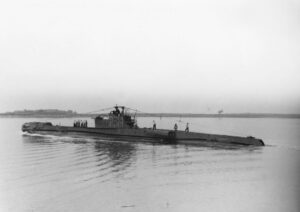 Tactician was laid down at Vickers Armstrong, Barrow on 13 November 1941, launched on 29 July 1942 and commissioned on 29 November 1942. She received the Pennant number P314. She served in the Mediterranean and the Far East. In the first theater, she sank the Italian auxiliary patrol vessel V17/Pia and sailing vessel Bice. She torpedoed the Italian merchant vessel Rosandra off the coast of Albania, she was finished off the following day. Her transfer to the Pacific under Lt. Cdr. Anthony Collett, DSC, saw her small Japanese vessel, two Siamese sailing vessels and she took part in Operation Cockpit, as plane guard for the 5th fleet, rescuing downed US airman under fire. She continued service postwar, until scrapped at Newport on 6 December 1963. The large T class had linger career than the U and S class boats due to their longer range and capabilities, they were perfect for reployments “east of suez”.
Tactician was laid down at Vickers Armstrong, Barrow on 13 November 1941, launched on 29 July 1942 and commissioned on 29 November 1942. She received the Pennant number P314. She served in the Mediterranean and the Far East. In the first theater, she sank the Italian auxiliary patrol vessel V17/Pia and sailing vessel Bice. She torpedoed the Italian merchant vessel Rosandra off the coast of Albania, she was finished off the following day. Her transfer to the Pacific under Lt. Cdr. Anthony Collett, DSC, saw her small Japanese vessel, two Siamese sailing vessels and she took part in Operation Cockpit, as plane guard for the 5th fleet, rescuing downed US airman under fire. She continued service postwar, until scrapped at Newport on 6 December 1963. The large T class had linger career than the U and S class boats due to their longer range and capabilities, they were perfect for reployments “east of suez”.
 HMS Truculent
HMS Truculent
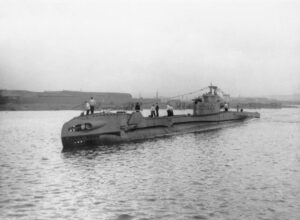 Truculent was laid down at Vickers Armstrong, Barrow on 4 December 1941, launched on 12 September 1942 and Commissioned on 31 December 1942 identified as P315. Her construction was funded by donations from the town of Glossop, Derbyshire (£175,000 in 1942-3). She was sent stright away in the Pacific Far East, after a short service in the Atlantic by early 1943. In the Norwegian Sea, she famously spotted and sank U-308 on her first patrol. She took part in Operation Source, towing the X-class X-6 to Norway to attack at anchorage, Tirpitz, Scharnhorst and Lützow. In the Pacific, she sank Yasushima Maru, Mantai and “hell ship” Harugiku Maru (180 out of 720 POWs went down) and five Japanese sailing vessels but also laid mines, damaging the Japanese minelayer Hatsutaka. Postwar back home she continued service with the Royal Navy. But On 12 January 1950 while returning to Sheerness after post refit trials at Chatham with 18 dockyard workers onboard she was in the Thames Estuary at night when at 19:00, three lights appeared ahead and she turned to port but could not avoid the Swedish oil tanker Divina from Purfleet, bound for Ipswich. In the collision (the sub could not avoid it without grounding) her bow was stuck into her starboard bow hydroplane, locked for a few seconds until she broke, flooded and sank with only 15 survivors picked up by a boat from the Divina and Dutch Almdijk. Most that escaped died in the freezing cold mid-winter mud islands waters, 64 men in all. The sub was refloated on 14 March, beached at Cheney Spit, moved inshore to recover 10 bodies, refloated on 23 March, towed to Sheerness and was sold for BU on 8 May. The loss contributed to invent the ‘Truculent light’n extra steaming all-round white light at the bow, placed high, to ensure subs remained highly visible at night.
Truculent was laid down at Vickers Armstrong, Barrow on 4 December 1941, launched on 12 September 1942 and Commissioned on 31 December 1942 identified as P315. Her construction was funded by donations from the town of Glossop, Derbyshire (£175,000 in 1942-3). She was sent stright away in the Pacific Far East, after a short service in the Atlantic by early 1943. In the Norwegian Sea, she famously spotted and sank U-308 on her first patrol. She took part in Operation Source, towing the X-class X-6 to Norway to attack at anchorage, Tirpitz, Scharnhorst and Lützow. In the Pacific, she sank Yasushima Maru, Mantai and “hell ship” Harugiku Maru (180 out of 720 POWs went down) and five Japanese sailing vessels but also laid mines, damaging the Japanese minelayer Hatsutaka. Postwar back home she continued service with the Royal Navy. But On 12 January 1950 while returning to Sheerness after post refit trials at Chatham with 18 dockyard workers onboard she was in the Thames Estuary at night when at 19:00, three lights appeared ahead and she turned to port but could not avoid the Swedish oil tanker Divina from Purfleet, bound for Ipswich. In the collision (the sub could not avoid it without grounding) her bow was stuck into her starboard bow hydroplane, locked for a few seconds until she broke, flooded and sank with only 15 survivors picked up by a boat from the Divina and Dutch Almdijk. Most that escaped died in the freezing cold mid-winter mud islands waters, 64 men in all. The sub was refloated on 14 March, beached at Cheney Spit, moved inshore to recover 10 bodies, refloated on 23 March, towed to Sheerness and was sold for BU on 8 May. The loss contributed to invent the ‘Truculent light’n extra steaming all-round white light at the bow, placed high, to ensure subs remained highly visible at night.
 HMS Templar
HMS Templar
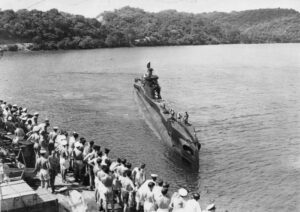 Templar was another Vickers boat, laid down on 28 December 1941, launched on 26 October 1942, commissioned on 15 February 1943 as P316. She served in Europe, Norway by 1943. She went into the Mediterranean in June 1943 and on 21 July under Lt. D.J. Beckley, she attacked but missed the Italian submarine Axum with seven torpedoes NW of Calvi, Corsica. On August, she covered the Combined convoy OS 53/KMS 23. On 5 Sep 1943 she departed from Beirut for Port Said as it has been decided to join the 4th Submarine Flotilla, Far East. There, she sank the Japanese merchant Kumano Maru (872 GRT, built 1941) on 28 May 1944 under Lt.RG Ridgeway off Malaya. In July she took part in a special operation for operation Crimson. She laid mines in June also in the Strait of Malacca (no kills). She also torpedoed (2 hits) and damaged the cruiser IJN Kitakami on 26 January 1944, and attacked U-1062 but missed off Sumatra on 16 July 1944.
Templar was another Vickers boat, laid down on 28 December 1941, launched on 26 October 1942, commissioned on 15 February 1943 as P316. She served in Europe, Norway by 1943. She went into the Mediterranean in June 1943 and on 21 July under Lt. D.J. Beckley, she attacked but missed the Italian submarine Axum with seven torpedoes NW of Calvi, Corsica. On August, she covered the Combined convoy OS 53/KMS 23. On 5 Sep 1943 she departed from Beirut for Port Said as it has been decided to join the 4th Submarine Flotilla, Far East. There, she sank the Japanese merchant Kumano Maru (872 GRT, built 1941) on 28 May 1944 under Lt.RG Ridgeway off Malaya. In July she took part in a special operation for operation Crimson. She laid mines in June also in the Strait of Malacca (no kills). She also torpedoed (2 hits) and damaged the cruiser IJN Kitakami on 26 January 1944, and attacked U-1062 but missed off Sumatra on 16 July 1944.
She survived the war and continued service until discarded, used as target; sunk in Loch Striven 1954. Salvaged on 4 December 1958, BU at Troon from July 1959. Full records.
 HMS Tally-Ho
HMS Tally-Ho
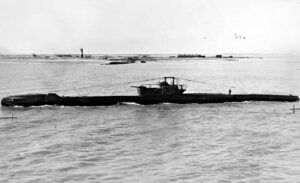 Laid down at Vickers on 25 March 1941 she was launched on 23 December 1942 and commissioned on 12 April 1943 as P317. Under Captain Leslie W. A. Bennington, Tally-Ho it was in the Far East that she earned her victories, sinking 13 small Japanese sailing vessels, a coaster, the water carrier Kisogawa Maru, cargo ships Ryuko and Daigen Maru No.6, auxiliary sub chaser Cha 2, auxiliary minelayer Ma 4, damaged a motor vessel, laid mines, damaging the merchant tanker Nichiyoku Maru. By 11 January 1944 from Trincomalee she spotted IJN Kuma and destroyer Uranami in exercises, 10 miles northwest of Penang. She fired seven torpedoes from 1,900 yards (1,700 m) and placed two hits on the cruiser starboard aft, she later sank by the stern. She sank also the German U-boat UIT-23 (former Italian Giuliani) off the western mouth of Malacca Strait, on 14 February 1944. In the night of 24 February 1944 she had a brief duel, surfaced with a Hayabusa-class TB, and submerged, but was damage in shallow waters. She waoted for 12 hours and surfaced attack after dark at 18:25 and managed to get back to Trincomalee via the Bay of Bengal under the Monsoon for repairs from 29 February. On 6 Oct 1944 she sank Cha-2 (130 tons) SW of Penang. On 9 Nov. 1944 she was in spec. ops. with an OSS team of Free Thai combatants at Ko Kradan, Trang Province. Postwar she served with the 6th Submarine Flotilla in Australia, in 1947, the 3rd at Rothesay. In 1949 she was sent to Canada relieving HMS Tudor to train with the RCN in ASW.She was assigned to the America and West Indies Squadron and in 1953 the coronation Fleet Review. Canada again in 1954, and made a submerged crossing snorkelling between Bermuda and UK over 3 weeks to gain experience in ‘snorting’ techniques. She was sold for BU on 10 February 1967. Full logs
Laid down at Vickers on 25 March 1941 she was launched on 23 December 1942 and commissioned on 12 April 1943 as P317. Under Captain Leslie W. A. Bennington, Tally-Ho it was in the Far East that she earned her victories, sinking 13 small Japanese sailing vessels, a coaster, the water carrier Kisogawa Maru, cargo ships Ryuko and Daigen Maru No.6, auxiliary sub chaser Cha 2, auxiliary minelayer Ma 4, damaged a motor vessel, laid mines, damaging the merchant tanker Nichiyoku Maru. By 11 January 1944 from Trincomalee she spotted IJN Kuma and destroyer Uranami in exercises, 10 miles northwest of Penang. She fired seven torpedoes from 1,900 yards (1,700 m) and placed two hits on the cruiser starboard aft, she later sank by the stern. She sank also the German U-boat UIT-23 (former Italian Giuliani) off the western mouth of Malacca Strait, on 14 February 1944. In the night of 24 February 1944 she had a brief duel, surfaced with a Hayabusa-class TB, and submerged, but was damage in shallow waters. She waoted for 12 hours and surfaced attack after dark at 18:25 and managed to get back to Trincomalee via the Bay of Bengal under the Monsoon for repairs from 29 February. On 6 Oct 1944 she sank Cha-2 (130 tons) SW of Penang. On 9 Nov. 1944 she was in spec. ops. with an OSS team of Free Thai combatants at Ko Kradan, Trang Province. Postwar she served with the 6th Submarine Flotilla in Australia, in 1947, the 3rd at Rothesay. In 1949 she was sent to Canada relieving HMS Tudor to train with the RCN in ASW.She was assigned to the America and West Indies Squadron and in 1953 the coronation Fleet Review. Canada again in 1954, and made a submerged crossing snorkelling between Bermuda and UK over 3 weeks to gain experience in ‘snorting’ techniques. She was sold for BU on 10 February 1967. Full logs
 HMS Tantalus
HMS Tantalus
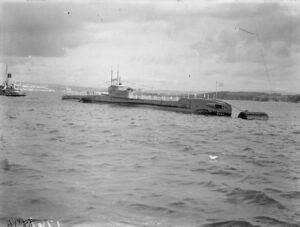 She was laid down at Vickers on 6 June 1942, launched on 24 February 1943 and commissioned on 2 June 1943 as P318. She served in the Far East, sinking the Malaysian tug Kampung Besar, Malaysian Pulo Salanama by April 1944, sank the army cargo ships Amagi Maru and Hiyoshi Maru, and Hachijin Maru, the coaster Palang Maru, fishing vessel Taisei Maru No. 12, a tug and three barges, an unknown Japanese vessel, a Siamese sailing vessel, and damaged a second. She also damaged a tug and the sub chaser Ch 1. She missed the Japanese submarine I-166, later reported and sunk the same day by HMS Telemachus. She survived the war and resumed service with the Royal Navy in 1946-49, until decommissioned and sold, scrapped at Milford Haven by November 1950. Full records
She was laid down at Vickers on 6 June 1942, launched on 24 February 1943 and commissioned on 2 June 1943 as P318. She served in the Far East, sinking the Malaysian tug Kampung Besar, Malaysian Pulo Salanama by April 1944, sank the army cargo ships Amagi Maru and Hiyoshi Maru, and Hachijin Maru, the coaster Palang Maru, fishing vessel Taisei Maru No. 12, a tug and three barges, an unknown Japanese vessel, a Siamese sailing vessel, and damaged a second. She also damaged a tug and the sub chaser Ch 1. She missed the Japanese submarine I-166, later reported and sunk the same day by HMS Telemachus. She survived the war and resumed service with the Royal Navy in 1946-49, until decommissioned and sold, scrapped at Milford Haven by November 1950. Full records
 HMS Tantivy
HMS Tantivy
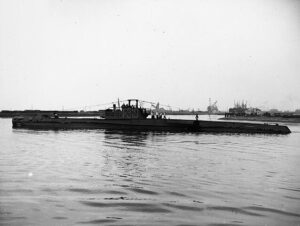 Tantivy was laid down on 4 July 1942, launched on 6 April 1943 and commissioned on 25 July 1943 at Vickers, as P319. She mostly served in the Far East, sank a Siamese sailing vessel, the merchant cargo ship Shiretoko Maru, Japanese communications vessel No. 137, barge No. 136, motor sailing vessel Tachibana Maru No.47, a tug and two coasters, a sailing vessel, as well as the “sea trucks” Chokyu Maru No.2, Takasago Maru No.3, and Otori Maru, and 12 small unidentified vessels, and also laid numerous mines in strategic passages and narrows for the IJN. She survived the war and remained in service with the RN in 1946-50 until decommissioned and disposed of as an anti-submarine target in the Cromarty Firth, 1951. Full records
Tantivy was laid down on 4 July 1942, launched on 6 April 1943 and commissioned on 25 July 1943 at Vickers, as P319. She mostly served in the Far East, sank a Siamese sailing vessel, the merchant cargo ship Shiretoko Maru, Japanese communications vessel No. 137, barge No. 136, motor sailing vessel Tachibana Maru No.47, a tug and two coasters, a sailing vessel, as well as the “sea trucks” Chokyu Maru No.2, Takasago Maru No.3, and Otori Maru, and 12 small unidentified vessels, and also laid numerous mines in strategic passages and narrows for the IJN. She survived the war and remained in service with the RN in 1946-50 until decommissioned and disposed of as an anti-submarine target in the Cromarty Firth, 1951. Full records
Group III, 1941 war emergency Program
 HMS Telemachus
HMS Telemachus
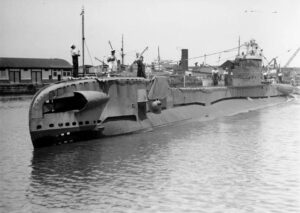 Telemachus was ordered on 3 August 1941 to Vickers Armstrong, Barrow (like the follow-up), laid down on 25 August 1942, launched on 19 June 1943 and commissioned on 25 October 1943 under the Pennant P321. After training in British waters and a few patrols, she was transferred via the Med to the Far East under command of Bill King, Eastern Fleet, Colombo from July 1944. On 17 July whilst, first far east patrol, she sank the submarine I-166 in the Strait of Malacca. She sighted her at 07:08 hours, fired six torpedoes from 2,300 yards (2,100 m), one hit 94 seconds later. Only a few crew survived. She was transferred to the 8th Submarine Flotilla in Fremantle and by October 1944 dropped intelligence operatives at Johore (Operation Carpenter).
Telemachus was ordered on 3 August 1941 to Vickers Armstrong, Barrow (like the follow-up), laid down on 25 August 1942, launched on 19 June 1943 and commissioned on 25 October 1943 under the Pennant P321. After training in British waters and a few patrols, she was transferred via the Med to the Far East under command of Bill King, Eastern Fleet, Colombo from July 1944. On 17 July whilst, first far east patrol, she sank the submarine I-166 in the Strait of Malacca. She sighted her at 07:08 hours, fired six torpedoes from 2,300 yards (2,100 m), one hit 94 seconds later. Only a few crew survived. She was transferred to the 8th Submarine Flotilla in Fremantle and by October 1944 dropped intelligence operatives at Johore (Operation Carpenter).
Post-war she ws designated to be based out of Sydney to assist RAN anti-submarine training, before acquiring the aircraft carrier HMAS Sydney, leaving Britain on 19 October 1949, arrived in December, first of the 4th Flotilla, with Thorough and Tactician. She was refitted at Singapore twice and operated off Japan to trained ships in the Korean War. By May 1954 she was with HMAS Anzac and HMAS Vengeance, HMNZS Black Prince with HMS Thorough.
In June-August 1956 she made an hydrographic survey off the Australian Antarctic Territory over 7,500 miles (12,100 km) with 130 gravity measurements under 50–200 feet (15–61 m). She was back home on 9 December 1959, scrapped at Charlestown on 28 August 1961. Full ww2 records
 HMS Talent
HMS Talent
 She had virtually no career under British flag. Talent was ordered and laid down at Vickers on 13 October 1942, launched on 17 July 1943 and transferred to the Royal Netherlands Navy on 23 March 1943. She was the first of two Free Dutch Navy subs. Most other Dutch subs had been sent to the far east fighting the Japanese with brio. She herself had an amazing career under Lieutenant Hendrikus Goossens, Zwaardvisch (Swordfish) trained in Holy Loch until February 1944, was in patrol in March, Atlantic and Norway and attempted to find Tirpitz before returning to Dundee. From the Portuguese coast in May, she headed for Gibraltar, and was ordered for the Far East via Trincomalee by July 1944. Under the Far East Fleet she patrolled through the Strait of Malacca, attacked ships such as the Kim Hup Soen and two Malaysian sailing vessels with her deck gun. With the 8th Submarine Flotilla she was based at Fremantle from September 1944 and in October, sank the Japanese guard boat Koei Maru, oceanographic research vessel Kaiyō No.2 and minelayer IJN Itsukushima, damaged the minelayer IJN Wakataka. On 6 October 1944, she sank the German submarine U-168 (six torpedoes, 2 hits). From Java she was vectored in ambush off Surabaya, surprised, torpedoed and the submarine underway with the VIP cargo for Japan. She rescued some survivors. In 1945 she operated in the South China Sea and Lombok Strait. In February 1945, but was damaged by a Japanese aircraft, repaired at Fremantle and back to the Java Sea under Lt. Jan van Dapperen, attacking merchantmen in April-May followed by repairs. After V-Day in Europe, she returned to Britain for full repairs in Dundee, then Rotterdam in August 1945. Postwar she made a single cruise to the Dutch West Indies in 1947. She was renamed Zwaardvis in 1950, decommissioned on 11 December 1962, sold for BU 12 July 1963.
She had virtually no career under British flag. Talent was ordered and laid down at Vickers on 13 October 1942, launched on 17 July 1943 and transferred to the Royal Netherlands Navy on 23 March 1943. She was the first of two Free Dutch Navy subs. Most other Dutch subs had been sent to the far east fighting the Japanese with brio. She herself had an amazing career under Lieutenant Hendrikus Goossens, Zwaardvisch (Swordfish) trained in Holy Loch until February 1944, was in patrol in March, Atlantic and Norway and attempted to find Tirpitz before returning to Dundee. From the Portuguese coast in May, she headed for Gibraltar, and was ordered for the Far East via Trincomalee by July 1944. Under the Far East Fleet she patrolled through the Strait of Malacca, attacked ships such as the Kim Hup Soen and two Malaysian sailing vessels with her deck gun. With the 8th Submarine Flotilla she was based at Fremantle from September 1944 and in October, sank the Japanese guard boat Koei Maru, oceanographic research vessel Kaiyō No.2 and minelayer IJN Itsukushima, damaged the minelayer IJN Wakataka. On 6 October 1944, she sank the German submarine U-168 (six torpedoes, 2 hits). From Java she was vectored in ambush off Surabaya, surprised, torpedoed and the submarine underway with the VIP cargo for Japan. She rescued some survivors. In 1945 she operated in the South China Sea and Lombok Strait. In February 1945, but was damaged by a Japanese aircraft, repaired at Fremantle and back to the Java Sea under Lt. Jan van Dapperen, attacking merchantmen in April-May followed by repairs. After V-Day in Europe, she returned to Britain for full repairs in Dundee, then Rotterdam in August 1945. Postwar she made a single cruise to the Dutch West Indies in 1947. She was renamed Zwaardvis in 1950, decommissioned on 11 December 1962, sold for BU 12 July 1963.
 HMS Terrapin
HMS Terrapin
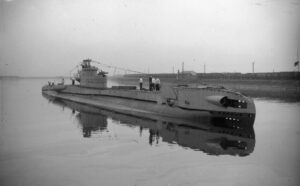 Terrapin was laid down on 19 October 1942, launched on 31 August 1943 and commissioned on 22 January 1944. She had a short career. By March 1944 she attacked a German convoy off Flekkefjord (Norway) badly damaging the German catapult ship Schwabenland, tanker Wörth (former Dutch Omala). The Schwabenland was later grounded at Sildeneset, Abelnes harbour to prevent sinking, Wörth was towed to port and never repaired. Terrapin was then reassigned to the Pacific Far East by mid 1944, bombarding Japanese installations at Gunung Sitoli in western Sumatr, sinking a Japanese coaster with gunfire, damaged another and sank the Japanese auxiliary netlayer Kumano Maru, minesweeper W 5, and ten Japanese sailing vessels, damaging more. She operated with HMS Trenchant to sink the tanker Yaei Maru No.6, auxiliary minesweeper Reisui Maru, sub chaser Ch 8, fishing vessel and seven coasters, many more small craft with gunfire. She was however badly damaged on 19 May 1945 after a vigorous depth charge attack by escort vessels while attacking a tanker. Assisted by USS Cavalla, she was escorted back to Fremantle, but after inspection, declared a constructive total loss, scrapped in June 1946. Full ww2 records
Terrapin was laid down on 19 October 1942, launched on 31 August 1943 and commissioned on 22 January 1944. She had a short career. By March 1944 she attacked a German convoy off Flekkefjord (Norway) badly damaging the German catapult ship Schwabenland, tanker Wörth (former Dutch Omala). The Schwabenland was later grounded at Sildeneset, Abelnes harbour to prevent sinking, Wörth was towed to port and never repaired. Terrapin was then reassigned to the Pacific Far East by mid 1944, bombarding Japanese installations at Gunung Sitoli in western Sumatr, sinking a Japanese coaster with gunfire, damaged another and sank the Japanese auxiliary netlayer Kumano Maru, minesweeper W 5, and ten Japanese sailing vessels, damaging more. She operated with HMS Trenchant to sink the tanker Yaei Maru No.6, auxiliary minesweeper Reisui Maru, sub chaser Ch 8, fishing vessel and seven coasters, many more small craft with gunfire. She was however badly damaged on 19 May 1945 after a vigorous depth charge attack by escort vessels while attacking a tanker. Assisted by USS Cavalla, she was escorted back to Fremantle, but after inspection, declared a constructive total loss, scrapped in June 1946. Full ww2 records
 HMS Thorough
HMS Thorough
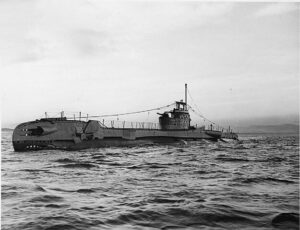 Thorough (which had a boar for emblem) was laid down on 26 October 1942, launched on 30 October 1943 and commissioned on 1 March 1944. She served in the Far East for much of her career, sinking twenty seven Japanese sailing vessels, seven coasters, a steam vessel, a barge, a small gunboat, a trawler, and the Malaysian sailing vessel Palange. In August 1945 with HMS Taciturn she preyed on shipping and shore targets off northern Bali, sank a coaster and sailing vessel with gunfire as well. Postwar she continued service.
Thorough (which had a boar for emblem) was laid down on 26 October 1942, launched on 30 October 1943 and commissioned on 1 March 1944. She served in the Far East for much of her career, sinking twenty seven Japanese sailing vessels, seven coasters, a steam vessel, a barge, a small gunboat, a trawler, and the Malaysian sailing vessel Palange. In August 1945 with HMS Taciturn she preyed on shipping and shore targets off northern Bali, sank a coaster and sailing vessel with gunfire as well. Postwar she continued service.
In Australian waters on 2 August 1956, she rescued a survivor from the sinking sixty-miler Birchgrove Park. On 16 December 1957 with HMS Dolphin she was back at Portsmouth after completing the first circumnavigation by a submarine. She was decommissioned and scrapped in June 1962 at Dunston on Tyne.
 HMS Thule
HMS Thule
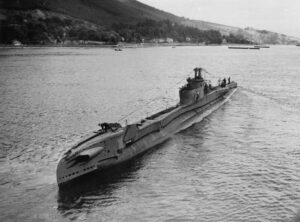 Thule (after the semi-mythical northern land) was laid down on 20 September 1941, launched on 22 October 1942 and commissioned on 13 May 1944 with the Pennant number P325. She was soon transferred to the Far East vioa the Mediterranean. But upon arrival, and given her theater of operations, targets were not aplenty. She sank 13 junks, 2 lighters and 5 sampans with gunfire, all in the Strait of Malacca over 12 days on 17-29 December 1944. She attacked Ro-113, believed her sunk but her torpedoes exploded prematurely. The submarine escaped unharmed. She later sank 5 sailing vessels, 3 coasters, and laid mines. Postwar she remained in service. In May 1951, she was sent to Canada to train with the RCN, and on 18 November 1960, as part of the 5th Submarine Squadron, she was in an ASW exercise off Portland Bill when accidentally rammed by the Auxiliary tanker Black Ranger, at periscope depth. Her snort and periscopes were bent, casing damaged. She was repaired and later decommissioned and scrapped at Thos. W. Ward from 14 September 1962. Her first captain wrote a book about her.
Thule (after the semi-mythical northern land) was laid down on 20 September 1941, launched on 22 October 1942 and commissioned on 13 May 1944 with the Pennant number P325. She was soon transferred to the Far East vioa the Mediterranean. But upon arrival, and given her theater of operations, targets were not aplenty. She sank 13 junks, 2 lighters and 5 sampans with gunfire, all in the Strait of Malacca over 12 days on 17-29 December 1944. She attacked Ro-113, believed her sunk but her torpedoes exploded prematurely. The submarine escaped unharmed. She later sank 5 sailing vessels, 3 coasters, and laid mines. Postwar she remained in service. In May 1951, she was sent to Canada to train with the RCN, and on 18 November 1960, as part of the 5th Submarine Squadron, she was in an ASW exercise off Portland Bill when accidentally rammed by the Auxiliary tanker Black Ranger, at periscope depth. Her snort and periscopes were bent, casing damaged. She was repaired and later decommissioned and scrapped at Thos. W. Ward from 14 September 1962. Her first captain wrote a book about her.
 HMS Tudor
HMS Tudor
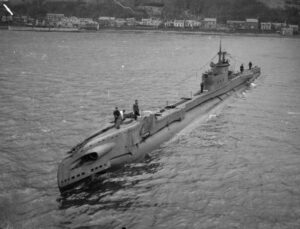 Built at Devonport Dockyard she was laid down on 20 September 1941, launched on 23 September 1942 (only ever named “Tudor” in the RN) and commissioned on 16 January 1944, Identification Pennant number P326. After training in home waters she transitioned to the Med via Port Said and Suez to the far east, joining the Far East Squadron (later British Pacific Fleet or BPF) for much of her career, sinking 5 Japanese sailing vessels, 4 Japanese coasters, a “sea truck” and an unidentified sailing vessel north of Sumatra. Back home she was adopted by the Borough of Bridgend, as part of Warship Week. She laso served in the cold war. On 23 April 1949 she was sent to Halifax for 3-month of Canadian surface ASW training, back n July, relieved by HMS Tally-Ho. After an unevetful career she was placed in reserve until sold for scrap on 1 July 1963 BU at Faslane.
Built at Devonport Dockyard she was laid down on 20 September 1941, launched on 23 September 1942 (only ever named “Tudor” in the RN) and commissioned on 16 January 1944, Identification Pennant number P326. After training in home waters she transitioned to the Med via Port Said and Suez to the far east, joining the Far East Squadron (later British Pacific Fleet or BPF) for much of her career, sinking 5 Japanese sailing vessels, 4 Japanese coasters, a “sea truck” and an unidentified sailing vessel north of Sumatra. Back home she was adopted by the Borough of Bridgend, as part of Warship Week. She laso served in the cold war. On 23 April 1949 she was sent to Halifax for 3-month of Canadian surface ASW training, back n July, relieved by HMS Tally-Ho. After an unevetful career she was placed in reserve until sold for scrap on 1 July 1963 BU at Faslane.
 HMS Tireless
HMS Tireless
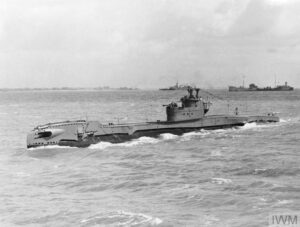
 HMS Token
HMS Token
 Sole ship ever with that name, HMS Toker was ordered to Portsmouth Dockyard, laid down on 6 November 1941, launched on 19 March 1943 but only commissioned on 15 December 1945 with the Pennant number P328. She missed WW2 and remains in home waters, having a relatively peaceful and uneventful cold war career. In 1953 she took part in the Fleet Review. She was modernised at Devonport Dockyard in 1955, based at the Home Station and Mediterranean, with refits at Malta. In 1965 she was in the 1st Submarine Squadron in Portsmouth, providing training to submarines crews and took part in Portsmouth ‘Navy Days’. On 20 August 1967 while on exercise off the West coast of Scotland she towed the powerless, adrift Danish merchant ship Opnor, preventing her drifting onto a reef. She was sold for scrap at Cairn Ryan in March 1970.
Sole ship ever with that name, HMS Toker was ordered to Portsmouth Dockyard, laid down on 6 November 1941, launched on 19 March 1943 but only commissioned on 15 December 1945 with the Pennant number P328. She missed WW2 and remains in home waters, having a relatively peaceful and uneventful cold war career. In 1953 she took part in the Fleet Review. She was modernised at Devonport Dockyard in 1955, based at the Home Station and Mediterranean, with refits at Malta. In 1965 she was in the 1st Submarine Squadron in Portsmouth, providing training to submarines crews and took part in Portsmouth ‘Navy Days’. On 20 August 1967 while on exercise off the West coast of Scotland she towed the powerless, adrift Danish merchant ship Opnor, preventing her drifting onto a reef. She was sold for scrap at Cairn Ryan in March 1970.
 HMS Tradewind
HMS Tradewind
 Built at Chatham, Tradewind (sole of this name) was laid down on 11 February 1942, launched on 11 December 1942 and commissioned on 18 October 1943 under the Pennant number P329. She started training in home waters, Scotland and Norway, until V-Day and was sent to the Far East, sinking nine Japanese sailing vessels, 2 small unidentified vessels, a tug and the merchant tanker Takasago Maru as well as indirectly the merchant Kyokko Maru which hit one of her mines. She also sank a major “hell ship”, unmarked by the Japanese, as they usually did despite Geneva convention. This led to another “unwilling war crime”, when she sank the cargo ship Junyō Maru heading for Sumatra on 18 September 1944. Not only she carried 4,200 Javanese slave labourers but also 2,300 Allied POWs from Batavia to Padang. 5,620 died in the sinking. This was one of the greatest tragedies on the Pacific theater.
Built at Chatham, Tradewind (sole of this name) was laid down on 11 February 1942, launched on 11 December 1942 and commissioned on 18 October 1943 under the Pennant number P329. She started training in home waters, Scotland and Norway, until V-Day and was sent to the Far East, sinking nine Japanese sailing vessels, 2 small unidentified vessels, a tug and the merchant tanker Takasago Maru as well as indirectly the merchant Kyokko Maru which hit one of her mines. She also sank a major “hell ship”, unmarked by the Japanese, as they usually did despite Geneva convention. This led to another “unwilling war crime”, when she sank the cargo ship Junyō Maru heading for Sumatra on 18 September 1944. Not only she carried 4,200 Javanese slave labourers but also 2,300 Allied POWs from Batavia to Padang. 5,620 died in the sinking. This was one of the greatest tragedies on the Pacific theater.
Post-war she was modified between July 1945 and September 1946 as an acoustic trials submarine, inspired by the recently acquired Type XXI as war reparation. Her external torpedo tubes and guns were removed, the bridge was faired, the hull streamlined, internal torpedo tubes blanked over. She became the prototype for the “T class conversion”. Tradewind data was used to overhaul the converted T class in order to act as hunter-killers against Soviet Whiskey class submarines (see below). In 1953 she took part in the coronation Fleet Review. She wa splaced in reserve and scrapped at Charlestown on 14 December 1955. Full records
 HMS Trenchant
HMS Trenchant
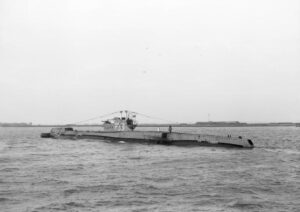 HMS Trenchant was ordered to Chatham Dockyard in 1941, laid down on 9 May 1942, launched on 24 March 1943 and commissioned on 26 February 1944 as P331. Under Commander Arthur Hezlet, DSO, DSC after home training she was sent to the Far East, operating from Trincomanlee in South East Asia against Japanese shipping. She sank many transports and even warships, with torpedoes and deck gun, even once by ramming, which is rare when done the other way around. She also operated in “fox pack” with her sister HMS Terrapin. On 23 September 1944 she sank U-859 which was tranitioning by night in the Straits of Malacca. Since she was surfaced, 11 escaped and were captured as POWs. On 27 October 1944 she was modified to carry “Chariots” for an operation against Phuket harbour, Siam. These sank only a Japanese Army cargo ship, the Sumatra Maru. But on 8 June 1945, she sank the Japanese cruiser Ashigara from 4,000 yards with 5 hits, out of 8 torpedoes fired. This showed the great advantage of their massive torpedo launching capabilities. This action earned commander Hezlet a second DSO as well as the US Legion of Merit, and battle honour “Malaya 1944-45”. To boot, IJN Ashigara was used as fast transport, carrying some 1,600 Japanese Army troops and materiel, which mostly went down with her. Her postwar records are unknown. She was sold for BU on 1 July 1963 at Faslane. Full records
HMS Trenchant was ordered to Chatham Dockyard in 1941, laid down on 9 May 1942, launched on 24 March 1943 and commissioned on 26 February 1944 as P331. Under Commander Arthur Hezlet, DSO, DSC after home training she was sent to the Far East, operating from Trincomanlee in South East Asia against Japanese shipping. She sank many transports and even warships, with torpedoes and deck gun, even once by ramming, which is rare when done the other way around. She also operated in “fox pack” with her sister HMS Terrapin. On 23 September 1944 she sank U-859 which was tranitioning by night in the Straits of Malacca. Since she was surfaced, 11 escaped and were captured as POWs. On 27 October 1944 she was modified to carry “Chariots” for an operation against Phuket harbour, Siam. These sank only a Japanese Army cargo ship, the Sumatra Maru. But on 8 June 1945, she sank the Japanese cruiser Ashigara from 4,000 yards with 5 hits, out of 8 torpedoes fired. This showed the great advantage of their massive torpedo launching capabilities. This action earned commander Hezlet a second DSO as well as the US Legion of Merit, and battle honour “Malaya 1944-45”. To boot, IJN Ashigara was used as fast transport, carrying some 1,600 Japanese Army troops and materiel, which mostly went down with her. Her postwar records are unknown. She was sold for BU on 1 July 1963 at Faslane. Full records
 HMS Tiptoe
HMS Tiptoe
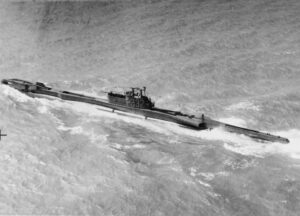 HMS Tiptoe, was personally named by Winston Churchill, which daughter was a ballet dancer at some point. She had a ballet dancer perfoming a tiptoe on her emblem. These links went on for all her career and her name remained unique in the RN.
HMS Tiptoe, was personally named by Winston Churchill, which daughter was a ballet dancer at some point. She had a ballet dancer perfoming a tiptoe on her emblem. These links went on for all her career and her name remained unique in the RN.
She was ordered in 1941 to Vickers Armstrong, Barrow, laid down on 10 November 1942, launched on 25 February 1944 and commissioned on 10 May 1944. The war already over in Europe. After training at Holy Loch, completed training on 10 September, returned to Barrow for fixed and between 5 October and 12 January 1944, equipped with new radar and other equipment for the Far East, later departing via Gibraltar, Malta, Port Said, Ismailia and Aden. She arrived in Trincomalee on 1 March 1945, and started her first war patrol, off the west coast of Burma and Andaman Islands. She ended in Fremantle, started her second patrol on 6 May to the Flores Sea. On 15 May, sinking a Japanese 100 tons coaster with gunfire near Dompo Bay in Sumbawa. The next day, another coaster, 200 tons, at Sepeh harbour. On 1 June, she sank the Japanese merchant cargo ship Tobi Maru near Matasiri, Laut Kecil. But she damaged during the attack by the escort, shook by 13 acccurate depth charges. She lost use of all torpedo tubes, and sonar equipment. Back to Fremantle on 17 June she was repaired until 16 July, departed for her 3rd patrol in the Sunda Strait with HMS Trump.
On 31 July she was gunning two small Japanese vessels when spotting an incoming aircraft. On 2 August, she spotted there again and sank them both, 600 tons, with gunfire. On 3 August, she torpedoed the cargo vessel Tencho Maru in convoy. Her final action was on 9 August with Trump, sinking by gunfire a very old 800-ton coastal tanker off Sunda Strait. She was back to Fremantle on 21 August 1945, celebrating V-day. In 1947 she was inspected by George VI, brought him underwater, and surfacing, firing her deck gun. In November she followed 7 subs and HMS Opportune in ASW training for two weeks. In 1951 she was rebuilt as a “streamline T”. She also took part in the 1950 film ‘Morning Departure’ directed by Roy Ward Baker with HMS Maidstone as mother ship. In 1952 was presented ballet dancer Moira Shearer ballet shoes after the 1948 film “The Red Shoes”. While at Tromsø on 18 July 1955 she collided with a coastal steamer, the 2,162 GRT Nordlys, entering the harbour, after colliding already with the destroyer HMS Chevron. This the destroyer in turn collided with Tiptoe, which snapped her moorings, and pushed halfway under a wooden quay.
She took part in escape trials in 1962 off Malta, from extreme depths, 233 feet (71 m), with ascent rates of up to 6.6 ft/s (2 m/s), testing buoyant ascent suits. Chief Petty Officer Christopher Crossman was awarded a commendation, LtCdr L. Hamlyn was awarded an OBE. After refit in Portsmouth, on 10 January 1964 in heavy fog she ran aground 40 yards (37 m) of her intended mooring. Divers assessed the damage, found none. She was refloated by the evening tide, pulled off by tugboats. LtCdr David Brazier, first command, was severely reprimanded for negligence at his court-martial. She later was damaged in a collision with HMS Yarmouth on 13 July 1965 while under periscope depth, 10 miles (16 km) southeast of Portland Bill. LtCdr Charles Henry Pope was severely reprimanded for 4 counts of negligence. Her final commission was on 24 February 1967, with six ballet dancers from the Royal Ballet attending her departure ceremony, and she was reported by the press as the oldest Royal Navy submarine, making an apparition at Portsmouth Navy Days. She was decommissioned in 1969, last ever T-class with a ceremony at Spithead on 29 August with 13-year-old ballet dancer Judy Wright dancing on her upper deck. She was sold in 1971, scrapped at Portsmouth, 1975. Unfortunately she was not preserved, bu her anchor was in Blyth, Northumberland and her oak nameplate is used in port and ceremonial occasions.
 HMS Trump
HMS Trump
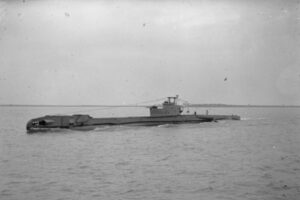 HMS Trump was laid down at Vickers on 31 December 1942, launched on 25 March 1944 and commissioned 8 July 1944 and with the pennant number P333. Trump after trials and a work-up in the North Sea by mid-October sailed for Perth, Western Australia, via the Mediterranean. She was assigned to the 4th Submarine Squadron (HMS Adamant) and from there conducted four patrols, sinking the Japanese guard boat No. 15 Shosei Maru on 13 May, a sailing vessel on 24 Ma, two coasters on 29 May and 1 June and a tanker on 5 June. With HMS Tiptoe, she sank a cargo vessel on 9 August, attacked a convoy on 3 August and sank Tencho Maru (credit to Tiptoe). She ended the war with the “Malaya 1945” battle honour. Postwar she was one of the streamlined T-class and she was one of two submarines with HMS Tabard, which bridge was incorporated into the added fin section, and last converted. In 1960 with Taciturn and Tabard se was with the 4th Submarine Flotilla at Sydney, Far East Fleet, and oparting to train ASW vessels of the RAN/RNZN, as well as “NEWS EX” exercise in the Hauraki Gulf, New Zealand. She had refits at Cockatoo Dockyard in 1962-1963, 1965-1966.She became the last T class on station in Australia, departing on 10 January 1969, privisionally as part of the 1st Australian Submarine squadron, waiting for the new Oberon class under construction to arrive. Back home she was scrapped at Newport from 1 August 1971.
HMS Trump was laid down at Vickers on 31 December 1942, launched on 25 March 1944 and commissioned 8 July 1944 and with the pennant number P333. Trump after trials and a work-up in the North Sea by mid-October sailed for Perth, Western Australia, via the Mediterranean. She was assigned to the 4th Submarine Squadron (HMS Adamant) and from there conducted four patrols, sinking the Japanese guard boat No. 15 Shosei Maru on 13 May, a sailing vessel on 24 Ma, two coasters on 29 May and 1 June and a tanker on 5 June. With HMS Tiptoe, she sank a cargo vessel on 9 August, attacked a convoy on 3 August and sank Tencho Maru (credit to Tiptoe). She ended the war with the “Malaya 1945” battle honour. Postwar she was one of the streamlined T-class and she was one of two submarines with HMS Tabard, which bridge was incorporated into the added fin section, and last converted. In 1960 with Taciturn and Tabard se was with the 4th Submarine Flotilla at Sydney, Far East Fleet, and oparting to train ASW vessels of the RAN/RNZN, as well as “NEWS EX” exercise in the Hauraki Gulf, New Zealand. She had refits at Cockatoo Dockyard in 1962-1963, 1965-1966.She became the last T class on station in Australia, departing on 10 January 1969, privisionally as part of the 1st Australian Submarine squadron, waiting for the new Oberon class under construction to arrive. Back home she was scrapped at Newport from 1 August 1971.
 HMS Taciturn
HMS Taciturn
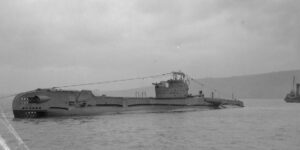 Taciturn was ordered to Vickers, laid down on 9 March 1943, launched on 7 June 1944, commissioned on 8 October 1944 under the pennant P334. She was sent for the Far East in 1945, operating from Austrlia and sinking a Japanese air warning picket hulk (salvaged former Dutch submarine K XVIII), auxiliary submarine chaser Cha 105, and a sailing vessel. On 1 August 1945 with HMS Thorough she was preying on shipping and shore targets off northern Bali and sank two sailing vessels with gunfire. Postwar, she on,e of the first to undergo the ‘Super T’ streamlining conversion. On 9 January 1958, she ran aground in the Firth of Clyde, was refloated, helped by the boom defence vessel HMS Barcombe. After a eventless career she was decommissioned and sold to Thos. W. Ward, scrapped at Briton Ferry in Wales by 8 August 1971.
Taciturn was ordered to Vickers, laid down on 9 March 1943, launched on 7 June 1944, commissioned on 8 October 1944 under the pennant P334. She was sent for the Far East in 1945, operating from Austrlia and sinking a Japanese air warning picket hulk (salvaged former Dutch submarine K XVIII), auxiliary submarine chaser Cha 105, and a sailing vessel. On 1 August 1945 with HMS Thorough she was preying on shipping and shore targets off northern Bali and sank two sailing vessels with gunfire. Postwar, she on,e of the first to undergo the ‘Super T’ streamlining conversion. On 9 January 1958, she ran aground in the Firth of Clyde, was refloated, helped by the boom defence vessel HMS Barcombe. After a eventless career she was decommissioned and sold to Thos. W. Ward, scrapped at Briton Ferry in Wales by 8 August 1971.
 HMS Tapir
HMS Tapir
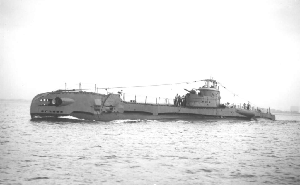 Tapir was laid down at Vickers Armstrong, Barrow on 29 March 1943, launched on 21 August 1944, and commissioned on 30 December 1944. She was transferred after local training and fixes in 1945 to Norwegian waters, spotted and torpedoed U-486 in the North Sea, north-west of Bergen, Norway on 12 April 1945, one of the last German submarine kills of the war. In May with the war ended in Europe she was transferred to the Far East, Fremantle base via Gibraltar, Malta, Port Said, Aden, Trincomanlee, and the Malaya-Burma-East Indies sector. But preys were rare, apart sampans. She was still in exercizes when the war ended in August. On 18 June 1948, she was surplus to requirements, loaned to the Netherlands for five years as HNLMS Zeehond from 12 July and purchased at the end of the loan (see below). Records
Tapir was laid down at Vickers Armstrong, Barrow on 29 March 1943, launched on 21 August 1944, and commissioned on 30 December 1944. She was transferred after local training and fixes in 1945 to Norwegian waters, spotted and torpedoed U-486 in the North Sea, north-west of Bergen, Norway on 12 April 1945, one of the last German submarine kills of the war. In May with the war ended in Europe she was transferred to the Far East, Fremantle base via Gibraltar, Malta, Port Said, Aden, Trincomanlee, and the Malaya-Burma-East Indies sector. But preys were rare, apart sampans. She was still in exercizes when the war ended in August. On 18 June 1948, she was surplus to requirements, loaned to the Netherlands for five years as HNLMS Zeehond from 12 July and purchased at the end of the loan (see below). Records
 HMS Tarn
HMS Tarn
Built at Vickers Armstrong, Barrow from 12 June 1943, launched on 29 November 1944 she was transferred to the Royal Netherlands Navy, completed and commissioned on 28 March 1945 as Tijgerhaai.She spent 1945 in trials wuth a quiet career, apart when HMS Sidon had a torpedo malfunction and sank. On 19 October 1955, she ran aground in Weymouth Bay, pulled off by tugs. She was decommissioned on 11 December 1964, sold for BU 5 November 1965. References: 1 2 3
 HMS Talent
HMS Talent
 HMS Talent was laid down at Vickers Armstrong, Barrow on 21 March 1944, launched on 13 February 1945 and commissioned on 27 July 1945 as P337. Given the fact the war over in less than a month she saw no combat, just starting training when it ended, in Scotland. She still had an eventful cold war career. She was sent in the Far East after and later back home, spent time at the mediterranean stations. In 1953 she was part of the Coronation Fleet Review. On 15 December 1954 she was washed out of drydock at Chatham Dockyard, not found until the following day, causing four death. After this, all caissons at Chatham on the river affected by tidal forces were chained down to prevent them lifting, inspected more regularly. She was refloated, repaired and converted as a streamined “super T” between 1954 and 1956. But soon she was again damaged in collision while diving off the Isle of Wight, on 8 May 1956. She was later used for publicity trip around the south and east coasts by October 1960, and iopened to public, visited by 33,000+. Refitted at Malta in 1960-1961, she remained in the Mediterranean until May 1962 and took part in Portsmouth Navy Days in 1965. She was decommissioned on 19 December 1966, scrapped at Troon in Scotland 1 February 1970.
HMS Talent was laid down at Vickers Armstrong, Barrow on 21 March 1944, launched on 13 February 1945 and commissioned on 27 July 1945 as P337. Given the fact the war over in less than a month she saw no combat, just starting training when it ended, in Scotland. She still had an eventful cold war career. She was sent in the Far East after and later back home, spent time at the mediterranean stations. In 1953 she was part of the Coronation Fleet Review. On 15 December 1954 she was washed out of drydock at Chatham Dockyard, not found until the following day, causing four death. After this, all caissons at Chatham on the river affected by tidal forces were chained down to prevent them lifting, inspected more regularly. She was refloated, repaired and converted as a streamined “super T” between 1954 and 1956. But soon she was again damaged in collision while diving off the Isle of Wight, on 8 May 1956. She was later used for publicity trip around the south and east coasts by October 1960, and iopened to public, visited by 33,000+. Refitted at Malta in 1960-1961, she remained in the Mediterranean until May 1962 and took part in Portsmouth Navy Days in 1965. She was decommissioned on 19 December 1966, scrapped at Troon in Scotland 1 February 1970.
 HMS Teredo
HMS Teredo
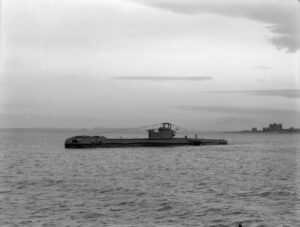 Built at Vickers Armstrong, from 17 April 1944, Teredo was launched on 27 April 1945 almost V-Day in Europe, and commissioned only by 13 April 1946. Construction was probably suspended in August 1945, and resumed postwar. Completely missing WW2 she had a short cold war career. She was under command of Gordon Tait 1947-1948. In 1953 she was at the Fleet Review celebrating the Coronation of Queen Elizabeth II. After a spotless career, not converted as a “streamlined T” she finally decommissioned, sold and scrapped at Briton Ferry, Wales on 5 June 1965.
Built at Vickers Armstrong, from 17 April 1944, Teredo was launched on 27 April 1945 almost V-Day in Europe, and commissioned only by 13 April 1946. Construction was probably suspended in August 1945, and resumed postwar. Completely missing WW2 she had a short cold war career. She was under command of Gordon Tait 1947-1948. In 1953 she was at the Fleet Review celebrating the Coronation of Queen Elizabeth II. After a spotless career, not converted as a “streamlined T” she finally decommissioned, sold and scrapped at Briton Ferry, Wales on 5 June 1965.
Group III, 1942 war emergency Program
 HMS Tabard
HMS Tabard
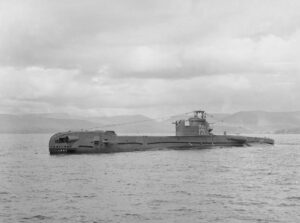 Tabard was built at Scotts Shipbuilding and Engineering Company in Greenock, laid down on 6 September 1944, launched on 21 November 1945 and commissioned on 25 June 1946 under the pennant number P342. She remained sole of her name in May 1943, which was an odd find. A “tabard” was an item of clothing, the official dress of a herald of the medieval era, another find of Churchill. That generation of late T class all missed WW2. They were completed postwar to a new design. Here is the story of the first.
Tabard was built at Scotts Shipbuilding and Engineering Company in Greenock, laid down on 6 September 1944, launched on 21 November 1945 and commissioned on 25 June 1946 under the pennant number P342. She remained sole of her name in May 1943, which was an odd find. A “tabard” was an item of clothing, the official dress of a herald of the medieval era, another find of Churchill. That generation of late T class all missed WW2. They were completed postwar to a new design. Here is the story of the first.
Tabard was originally ordered from Vickers, but switched to Scotts Shipbuilding and re-ordered latr as P.342, completed on 25 June 1946 as part of 14 boats of the 1942 Programme, one of five advanced enough at V day to be completed. She lacked the CT 4 inch gun and full shield, but instead had a standard open gun mounting and a Oerlikon 20 mm AA gun wa sinstalled on the aft deck. The mounting which was modified with holes cut in the pedestal for drainage.
After commissioned she was sent for Mediterranean duties and by March 1949, took part in Operation Two Step training exercise with the massed Home Fleet joint with the Mediterranean Fleet, largest concentration since Operation Torch. On 17 January 1950 she escorted HMS Chequers with Prince Philip (Duke of Edinburgh) and HMS Surprise with Admiral Sir Arthur Power in an official meeting to King Ibn Saud of Saudi Arabia at Jeddah. While refitted at Malta in June 1950, she was damaged by electrical cables installed by a disgruntled workman. By 18 December 1950, she rescued Roi Wilson (later captain of the Royal Naval College) after his Fairey Firefly crashed down at sea.
The British admiralty received a German Type XXIII submarine. The elektroboote was tested and reports were made, so the Admiralty decided to modify eight late T-class after many of these observations: Enlarging the batteries, increasing electric motors power, greatly streamline the hull.
In 1951, Tabard was taken in hand for a radical reconstruction. Her pressure hull was cut at the after end of the engine room. A new section was addeded there of 20 feet (6.1 m). This helped installing an additional battery compartment and two more electric motors. No longer direct, the powerplant became a diesel–electric transmission. HMS Trump was also modified that way, and her bridge was made into a streamlined fin, which was another novelty at the time. All external fittings were removed (see the streamlined T conversion below), and the periscopes, radar masts, snort mast and wireless mast were now enclosee flush with he top of a completely new, well faired bridge fin.
In 1960, Tabard, Taciturn and Trump were sent to the 4th Submarine Squadron in Sydney, refitted at Cockatoo in 1961-1962 and served with Far East Fleet, RAN and RNZN. By April 1963 she collided with a wharf when docking in Brisbane. On 8 May she collided with HMAS Queenborough (at periscope depth), repaired in Sydney, HMAS Kuttabul. On 10 February 1964, she she was in ASW exercise as the prey for HMAS Melbourne and HMAS Voyager and later helped to rescue the crew of the latter when she was cut in half after being rammed by the carrier by accident. Tabard took part in the NEWS EX exercise in Hauraki Gulf and was refitted 1964-1965, then joined the newly formed 1st Australian Submarine Squadron in 1967 on loan to the RAN before new subs arrived. She was back home by March 1968, moored as static training hull at HMS Dolphin 1969-1974, replaced by HMS Alliance and decommisioned, last T class in service, sold for scrap on 2 January 1974.
 HMS Totem
HMS Totem
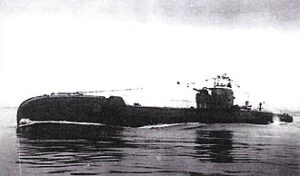 Totem was ordered as part of the 1941, then 1942 program, built at HM Dockyard Devonport from 22 October 1942, launched on 28 September 1943 and commissioned on 9 January 1945 as P352.
Totem was ordered as part of the 1941, then 1942 program, built at HM Dockyard Devonport from 22 October 1942, launched on 28 September 1943 and commissioned on 9 January 1945 as P352.
She saw little service in wartime, being trained when the war ended. She was soon fitted with a snorkel mast. By January 1948 she was scheduled to intercept Soviet submarines from bases in Northern Russia and in April, the Assistant CNS, Rear-Admiral Geoffrey Oliver proposed she would be converted and msidied to lay mines off these bases and then lay in ambush. For this, she needed reconstruction as part of the “T streamline” serie, to be exact the late “super T-conversions” between 1951 and May 1953 at Chatham. Her airguard radar aerial was also removed.
Under Commander John Coote in exercises easy, she left her hunting escorts “in the dust” as she made a mile in four minutes at 18 knots (33 km/h) and could stay ten minutes silentl at 12 knots (22 km/h) making 3 miles (4.8 km) away. In 1953 she took part in the Fleet Review. By early 1955 she was at “Operation Defiant” in the Barents Sea, to gather Signals intel. on Soviet naval forces. She was however detected and depth charged, crash dove to 280 feet (85 m) to evade but drifting into a minefield. She was unharmed and came back home.
She was refitted at Malta in 1961-1963, recom. at HMNB Portsmouth with a new crew from 28 January, 1st Submarine Flotilla, Gosport. In Halifax in the 1945 she was presented a totem pole by the Cowichan Tribes in 1945, later stolen when she was in Halifax, Canada. She was fitted to the front of her bridge fin while in harbour.
She was sold to the Israeli Navy in 1965, as INS Dakar, but famously sunk during transfer.
 HMS Truncheon
HMS Truncheon
Truncheon (a kind of medieval mace) was laid down at Devonport on 5 November 1942, launched on 22 February 1944 and commissioned on 25 May 1945. She was training as the war ended. Postwar she was retained and fitted with a snorkel mast. In October 1945 she was sent to the far east but postwar records are unknown (ww2 logs). Back home she was converted as a “T streamlined” and remained in operation against Soviet subs of the north sea. Surplus, she was sold to the Israeli Navy in 1968, renamed INS Dolphin, just like HMS Turpin and HMS Totem, commissioned into the Israeli Sea Corps and eventually scrapped in 1977 as the one and only last T class submarine in service.
 HMS Turpin
HMS Turpin
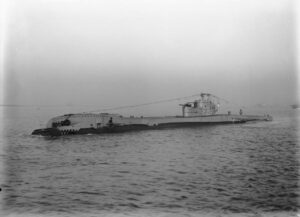 Turpin (either after a land tortoise or after the English highwayman 1706-1739 Dick Turpin as the amblem showed his steed) was built at Chatham, laid down on 24 May 1943, launched on 5 August 1943 and commissioned on 18 December 1944. She saw little service ib WW2. She transited by Scapa Flow to Holy Loch for training in the Clyde area and conduct conducted torpedo discharge trials off Arrochar and A/S exercises off Loch Alsh. Her 1st patorl started on 6 Apr 1945 off Norway. On 12 June she was sent for the Far East via the Mediterranean and reached Fremantle in August, she trained there when the war ended. WW2 logs on uboat.net
Turpin (either after a land tortoise or after the English highwayman 1706-1739 Dick Turpin as the amblem showed his steed) was built at Chatham, laid down on 24 May 1943, launched on 5 August 1943 and commissioned on 18 December 1944. She saw little service ib WW2. She transited by Scapa Flow to Holy Loch for training in the Clyde area and conduct conducted torpedo discharge trials off Arrochar and A/S exercises off Loch Alsh. Her 1st patorl started on 6 Apr 1945 off Norway. On 12 June she was sent for the Far East via the Mediterranean and reached Fremantle in August, she trained there when the war ended. WW2 logs on uboat.net
She was fitted with a snort mast and in 1955, was in the arctic circle on an ELINT mission (listening to specific frequency bands of Soviet radars). They were nearly rammed by a Soviet Navy surface vessel, making a crash dive was ordered and later taking refuge in a cold water line to evade their sonar and escape. She was was sold to the Israeli Navy in 1965, renamed INS Leviathan (after the biblical sea monster), commissioned into the Israeli Sea Corps in 1967 and scrapped in 1978, the very last T class still in service anywhere in the world. Too bad she was not preserved.
 HMS Thermopylae
HMS Thermopylae
 Named after the Spatran battle, the last T class ever commissioned (Tiara, the next most advanced was never completed), she was built at Chatham from 26 October 1943, launched on 27 June 1945 and commissioned on 5 December 1945 as P355. The war being over since two months, she only trained in Scottish waters and joined the 3rd Flotilla in the Holy Loch. On 15 January 1950 she ran aground on Stevenson Rock (Skerryvore, Inner Hebrides). In 1953 she was at the Coronation fleet review. She was in service until December 1968, sold for BU at Troon in 1971.
Named after the Spatran battle, the last T class ever commissioned (Tiara, the next most advanced was never completed), she was built at Chatham from 26 October 1943, launched on 27 June 1945 and commissioned on 5 December 1945 as P355. The war being over since two months, she only trained in Scottish waters and joined the 3rd Flotilla in the Holy Loch. On 15 January 1950 she ran aground on Stevenson Rock (Skerryvore, Inner Hebrides). In 1953 she was at the Coronation fleet review. She was in service until December 1968, sold for BU at Troon in 1971.
Cancelled on 29 October 1945
 Thor
Thor
Thor (P349) was laid down at Portsmouth Dockyard on 5 April 1943, launched on 18 April 1944. The war ended before completion. She was sold for scrapping to Rees Shipbreaking Co Ltd of Llanelli in Wales by July 1946.
 HMS Tiara
HMS Tiara
Tiara was also launched on 18 April 1944 at Portsmouth but not completed, BU on slip.
 HMS Theban
HMS Theban
Theban (P341) was never completed, BU on slip.
 HMS Talent
HMS Talent
Talent (P343) was never completed, BU on slip.
 HMS Threat
HMS Threat
Threat (P344) was never completed, BU on slip.
 P345, P346, P347, P348
P345, P346, P347, P348
None laid down, unnamed.
Cold war Modernization: The “Streamline T”

HMS Tabard and Trump, the last two and best “super-T” conversions. The streamlining was the most advanced. If they look like the “A” class streamlining conversion or the later Oberons, it’s not random, they were the trailblazers. 2/2/1967, at Bluff NZ, coming from Dunedin. Credit: shipsnoslalgia
Postwar, all surviving Group 1 and 2 boats were scrapped. The remainder were fitted with snorts. Then from 1947 the new thteat posed by the USSR caused some concerns about the use by the Soviet Navy of ex-Type XXIs, which were a new standard of mich faster underwater submarines, streamlined. When it was confirmed the next year, it was planned by the admirakty to built a new generation of submarines, but also modernize the one it had, as the USN as just starting to do with its legacy Balao and Tench class boats.
The idea to streamline the T class was an obvious one as the latter were the largest, long range in the inventory. They were built from welded hulls for most and has extra room for upgrade. It was decided to imprive the hill to reach greater underwater speeds, quieter, and press operation against Soviet submarines. This new role of hunter killer was a complet doctrinal change from their WW2 traditional anti-surface-ship role.

Early T class conversion as example. Gouache of HMS Taciturn in this configuration
In January 1948, this main operational function was made official. They were tasked to intercept Soviet submarines slipping out from Northern Russia to the northern Atlantioc, preying on British and Allied merchant lines. In April 1948, the Assistant Chief of Naval Staff, Rear-Admiral Geoffrey Oliver, proposed in a document which circulated in the naval staff, that British submarines needed to be mofified to take a more proactive role as well, of attacking Soviet submarines off the Northern Russian coast, and mining the waters close to their base to prevent any sortie in the first place. This was also a calculation resulting of the postwar budget cuts with many submarines being decommissioned. It was easier to be proactive and reduce the number od Soviet subs that could venture out of these constricted waters, rather than trying to intercept them all afterwars, when “diluted” and spread out in the Atlantic. This was a method called upon for “getting to the enemy on his home ground.”
The work carried out on these submarines was delayed also for the results of measurements using HMS Tradewind, modified between July 1945 and September 1946 as an acoustic trials submarine. This was the first “T streamline”. It had its external tubes and guns removed and the conning tower completely faired out. The hull was much streamlined (angles were eliminated, the surface was smoothed out, water intake scopes were eliminated) and the remainder internal torpedo tubes blanked over so that no extrusion was left.
HMS Tradewind was well tested in 1946-48, and the results were used to create a new conversion standard.
From 1948, eight brand new late production all-welded boats were selectd for conversion. This was called the “Super-T” conversion at Chatham Dockyard. These modifications included the following:
-Removal of deck guns
-Replacement of the conning tower with a “fin” (further improved)
-Smooth-surfaced, symmetrical, streamlined hull overall with elimination of all angles.
-Extra battery installed below the control room
-New hull section inserted* for an extra pair of motors plus switchgear.
-Diesel engines modified and supercharged at 300 bhp (224 kW).
-Bow reshaped.
-Section ranging from 14 feet (4.3 m) in the first batch of 4, then 17 feet 6 inches (5.33 m) in the late batch.
Performances:
Tested underwater speed of 15 knots (28 km/h; 17 mph), endurance 32 hours at 3 knots (5.6 km/h; 3.5 mph).
The additional electric motors were accommodated by cutting through the pressure hull and adding in a new 20 ft (6 m) hull section aft of the control room.
HMS Taciturn was the first to be modified in November 1948 until March 1951, followed by HMS Turpin in June 1949 to September 1951.
The programme was completed with the conversion of HMS Trump in February 1954 to June 1956.
The conversion was not a complete success: Their metacentric height was reduced, so they rolled heavily while surface in rough weather. In 1953 in the later conversions, increasing the buoyancy was done, by raising the capacity of a the main ballast tank by 50 tons, merging these with an existing emergency oil fuel tank. For the four ones to be converted, it was decided to increase their buoyancy was lengthening the extra hull section from 14 to 17 feet 6 inches. This also enabling to englarge the control room but with the catch no new heavy equipment was to be allocated to this space, to not degrade buoyancy and top weight. So this seriously upgrade potential on the long run.
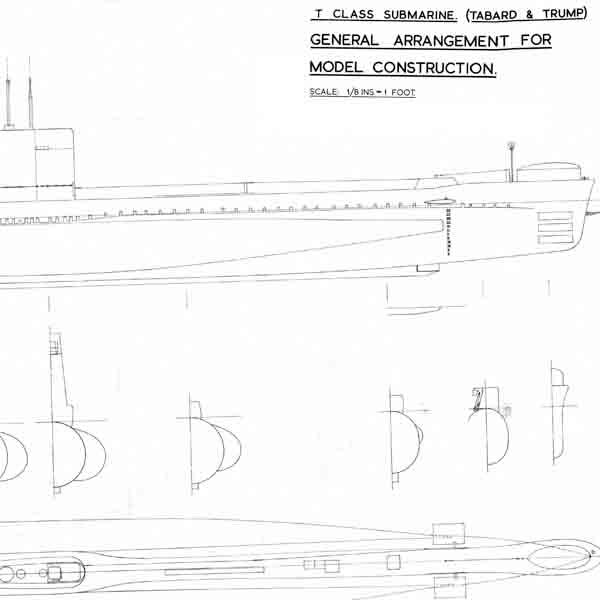
Late “super T” conversion plans src
By December 1950, the further streamlining of five older riveted boats was approved, but in a more “austere” upgrade:
Removal of deck guns and external torpedo tubes
Replacement of the conning tower by a simpler “fin”
Replacement of the batteries by more modern versions for 23% increase in power.
No new section added and the hull remained the same.
This limited work could be done under normal refit. The first of these “limited streamlined” riveted boats was HMS Tireless in 1951.
The last operational T class in the RN was HMS Tiptoe, decommissioned on 29 August 1969. The last non-operational was HMS Tabard, permanently moored as a static training submarine, at the shore establishment HMS Dolphin 1969-1974, until replaced by HMS Alliance.
However beyond Britain, the very last operational boat anywhere was the INS Dolphin, formerly HMS Truncheon, sold to the Israeli Navy and decommissioned only by 1977 whe the new Gal class were available.INS Dakar, was lost and of her wreck was discovered in 1999, the accident cause remains uncertain.
Note: These will be a dedicated post on these conversions in 2026 or 2027.
Exports
 Zwaardvisch class (1943)
Zwaardvisch class (1943)
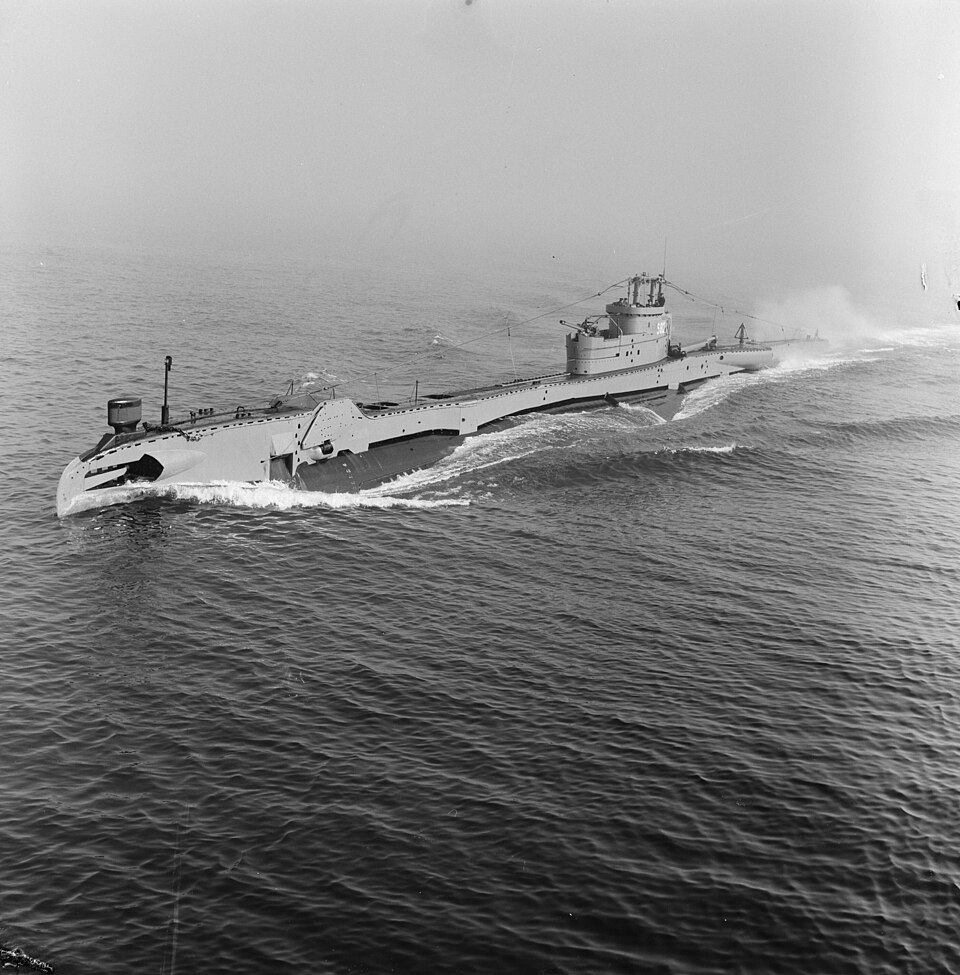
The last Group thus saw very little of the war, and four went to the Royal Netherlands Navy, transferred in 1943-44 to serve with the Free Dutch sailors that were avilable, and formed together the Zwaardvisch class. Two were returned in 1953.
Tijgerhaai (ex-Tarn) was transferred in 1944, Zwaardvisch (ex-Talent) was transferred in 1943, Zeehond (ex-Tapir) was transferred 1948 and returned in 1953 and Dolfijn (ex-Taurus) was transferred in 1948 and returned in 1953. So in short: Two were actived with the Free Dutch Navy in 1944-45, then Netherlands Navy as training boats until two new boats were transferred in 1948. When the transition was done, the two ealier boats, Tijgerhaai and Zwaardvisch were returned to the RN and scrapped in 1953, and the modernized Zeehond and Dolfijn remained active for many more years.
 Leviathan class (1965)
Leviathan class (1965)
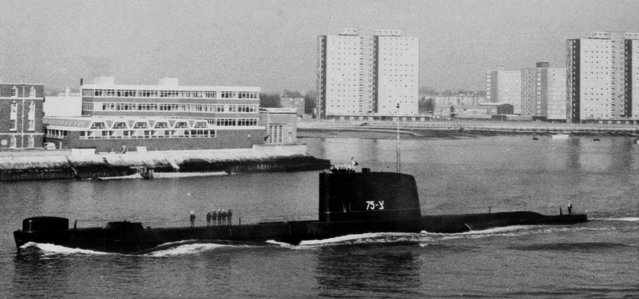
INS Leviathan leaves Portsmouth in 1967. Note she saw service in the RN already as a “streamlined-T”.
Transfers to the Israeli Navy: Three sold to the still young Israeli Navy in the 1960s. Totem (INS Dakar) was famously lost in transit in 1968. She had been sold 1965 in commissioned 1967, then lost in January 1968. Then, there were INS Dolphin (ex-Truncheon) sold as replacement in 1968, and INS Leviathan (ex-Turpin) sold after Dakar in 1965, commissioned at the same time in 1967. They had a long service life, until replacement by more modern German Type 206s (Gal class). Before the T class, Israel also acquired stock S-class boats, INS Tanin and Rahav, acquired in 1958 and stricken 1968 and 1972, they had been turned as training subs before the acquisition of the T class.
Read More/Src
Books
Akermann, Paul (2002). Encyclopaedia of British Submarines 1901–1955 (reprint of the 1989 ed.). Periscope Publishing.
Bagnasco, Erminio (1977). Submarines of World War Two. Annapolis, Maryland: Naval Institute Press.
Brown, D. K. (2000). Nelson to Vanguard. Chatham Publishing.
Clayton, Tim (2011). Sea Wolves. London. Abacus.
Colledge, J. J.; Warlow, Ben (2006) [1969]. Ships of the Royal Navy: The Complete Record of all Fighting Ships of the Royal Navy (Rev. ed.). Chatham Publishing.
Chesneau, Roger, ed. (1980). Conway’s All the World’s Fighting Ships 1922–1946. Greenwich, UK: Conway Maritime Press.
Greentree, David (2016). British submarine vs Italian torpedo boat : Mediterranean 1940-43. Oxford: Osprey Publishing.
Kemp, Paul J. (1990). The T-class Submarine: The Classic British Design. Annapolis, Maryland: Naval Institute Press.
Mars, Alistair (1971). British Submarines at War 1939-1945. London. William Kimber.
McCartney, Innes (2006). British Submarines 1939–1945. New Vanguard. Vol. 129. Oxford, UK: Osprey.
van den Pol, E. (1989). “Aspects of submarines – Part I: Some notes on development”. Schip en Werf. Vol. 56, no. 10. Rotterdam: Wyt & Zonen. pp. 352–358.
Links
uboat.net/
transportsofdelight.smugmug.com
battleships-cruisers.co.uk/triton_class.htm
worldnavalships.com/triton_class.htm
navypedia.org/ t_prewar.htm
navypedia.org t_war_1940.htm
navypedia.org/ t_1941_1942
en.wikipedia.org British_T-class
navweaps.com British Torpedoes
rmg.co.uk/collections/
commons.wikimedia.org/ British_T_class_sub
rnsubs.co.uk t-class.html
rnsubs.co.uk/ sonar.html
uboat.net: Triton
rmg.co.uk/collections/
laststandonzombieisland.com/
hansonclan.co.uk/
britsub.x10.mx/ t_class3_1940.html
deviantart.com/ British-T-Class-Submarine
dailypost.co.uk/ hms-thetis-sank-coast
dailyecho.co.uk/
thefreelibrary.com/
uboat.net/
iwm.org.uk collections/
warhistoryonline.com/
ibtimes.co.uk/
metro.co.uk/
bbc.com/
rnsubs.co.uk/ T class conversion
http://www.royalnavy.mod.uk/
Videos
Dr Alex Clarke, T class submarines
Model Kits
scalemates.comT class group-II
starling-models.co.uk/
on sdmodelmakers.com
on britmodeller.com/

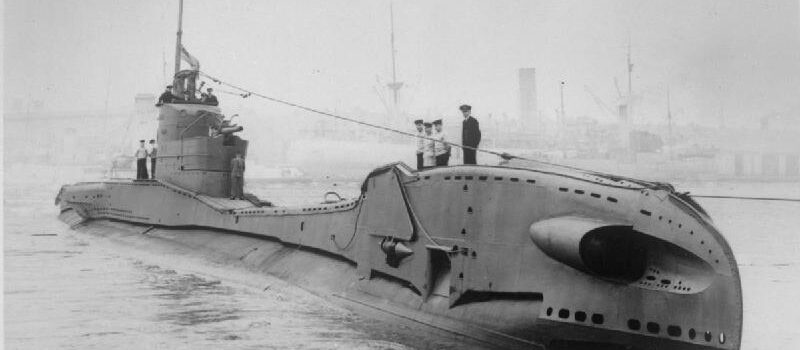

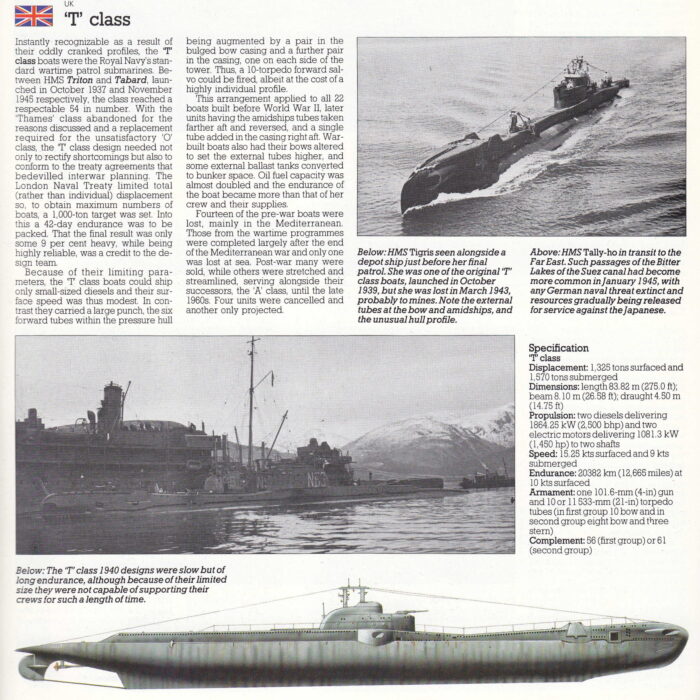
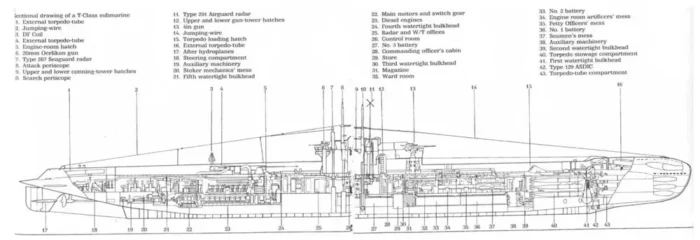
 Latest Facebook Entry -
Latest Facebook Entry -  X(Tweeter) Naval Encyclopedia's deck archive
X(Tweeter) Naval Encyclopedia's deck archive Instagram (@navalencyc)
Instagram (@navalencyc)





 French Navy
French Navy Royal Navy
Royal Navy Russian Navy
Russian Navy Armada Espanola
Armada Espanola Austrian Navy
Austrian Navy K.u.K. Kriegsmarine
K.u.K. Kriegsmarine Dansk Marine
Dansk Marine Nautiko Hellenon
Nautiko Hellenon Koninklije Marine 1870
Koninklije Marine 1870 Marinha do Brasil
Marinha do Brasil Osmanlı Donanması
Osmanlı Donanması Marina Do Peru
Marina Do Peru Marinha do Portugal
Marinha do Portugal Regia Marina 1870
Regia Marina 1870 Nihhon Kaigun 1870
Nihhon Kaigun 1870 Preußische Marine 1870
Preußische Marine 1870 Russkiy Flot 1870
Russkiy Flot 1870 Svenska marinen
Svenska marinen Søværnet
Søværnet Union Navy
Union Navy Confederate Navy
Confederate Navy Armada de Argentina
Armada de Argentina Imperial Chinese Navy
Imperial Chinese Navy Marinha do Portugal
Marinha do Portugal Mexico
Mexico Kaiserliche Marine
Kaiserliche Marine 1898 US Navy
1898 US Navy Sovietskiy Flot
Sovietskiy Flot Royal Canadian Navy
Royal Canadian Navy Royal Australian Navy
Royal Australian Navy RNZN Fleet
RNZN Fleet Chinese Navy 1937
Chinese Navy 1937 Kriegsmarine
Kriegsmarine Chilean Navy
Chilean Navy Danish Navy
Danish Navy Finnish Navy
Finnish Navy Hellenic Navy
Hellenic Navy Polish Navy
Polish Navy Romanian Navy
Romanian Navy Turkish Navy
Turkish Navy Royal Yugoslav Navy
Royal Yugoslav Navy Royal Thai Navy
Royal Thai Navy Minor Navies
Minor Navies Albania
Albania Austria
Austria Belgium
Belgium Columbia
Columbia Costa Rica
Costa Rica Cuba
Cuba Czechoslovakia
Czechoslovakia Dominican Republic
Dominican Republic Haiti
Haiti Hungary
Hungary Honduras
Honduras Estonia
Estonia Iceland
Iceland Eire
Eire Equador
Equador Iran
Iran Iraq
Iraq Latvia
Latvia Liberia
Liberia Lithuania
Lithuania Mandchukuo
Mandchukuo Morocco
Morocco Nicaragua
Nicaragua Persia
Persia San Salvador
San Salvador Sarawak
Sarawak Uruguay
Uruguay Venezuela
Venezuela Zanzibar
Zanzibar Warsaw Pact Navies
Warsaw Pact Navies Bulgaria
Bulgaria Hungary
Hungary

 Bundesmarine
Bundesmarine Dutch Navy
Dutch Navy Hellenic Navy
Hellenic Navy Marina Militare
Marina Militare Yugoslav Navy
Yugoslav Navy Chinese Navy
Chinese Navy Indian Navy
Indian Navy Indonesian Navy
Indonesian Navy JMSDF
JMSDF North Korean Navy
North Korean Navy Pakistani Navy
Pakistani Navy Philippines Navy
Philippines Navy ROKN
ROKN Rep. of Singapore Navy
Rep. of Singapore Navy Taiwanese Navy
Taiwanese Navy IDF Navy
IDF Navy Saudi Navy
Saudi Navy Royal New Zealand Navy
Royal New Zealand Navy Egyptian Navy
Egyptian Navy South African Navy
South African Navy






























 Ukrainian Navy
Ukrainian Navy dbodesign
dbodesign